NAME
Examples - Excel::Writer::XLSX example programs.
DESCRIPTION
This is a documentation only module showing the examples that are included in the Excel::Writer::XLSX distribution.
This file was auto-generated via the gen_examples_pod.pl program that is also included in the examples directory.
Example programs
The following is a list of the 59 example programs that are included in the Excel::Writer::XLSX distribution.
"Example: a_simple.pl" A simple demo of some of the features.
"Example: bug_report.pl" A template for submitting bug reports.
"Example: demo.pl" A demo of some of the available features.
"Example: formats.pl" All the available formatting on several worksheets.
"Example: regions.pl" A simple example of multiple worksheets.
"Example: stats.pl" Basic formulas and functions.
"Example: autofilter.pl" Examples of worksheet autofilters.
"Example: array_formula.pl" Examples of how to write array formulas.
"Example: cgi.pl" A simple CGI program.
"Example: chart_area.pl" A demo of area style charts.
"Example: chart_bar.pl" A demo of bar (vertical histogram) style charts.
"Example: chart_column.pl" A demo of column (histogram) style charts.
"Example: chart_line.pl" A demo of line style charts.
"Example: chart_pie.pl" A demo of pie style charts.
"Example: chart_scatter.pl" A demo of scatter style charts.
"Example: chart_stock.pl" A demo of stock style charts.
"Example: colors.pl" A demo of the colour palette and named colours.
"Example: data_validate.pl" An example of data validation and dropdown lists.
"Example: date_time.pl" Write dates and times with write_date_time().
"Example: defined_name.pl" Example of how to create defined names.
"Example: diag_border.pl" A simple example of diagonal cell borders.
"Example: filehandle.pl" Examples of working with filehandles.
"Example: headers.pl" Examples of worksheet headers and footers.
"Example: hide_sheet.pl" Simple example of hiding a worksheet.
"Example: hyperlink1.pl" Shows how to create web hyperlinks.
"Example: hyperlink2.pl" Examples of internal and external hyperlinks.
"Example: indent.pl" An example of cell indentation.
"Example: merge1.pl" A simple example of cell merging.
"Example: merge2.pl" A simple example of cell merging with formatting.
"Example: merge3.pl" Add hyperlinks to merged cells.
"Example: merge4.pl" An advanced example of merging with formatting.
"Example: merge5.pl" An advanced example of merging with formatting.
"Example: merge6.pl" An example of merging with Unicode strings.
"Example: mod_perl1.pl" A simple mod_perl 1 program.
"Example: mod_perl2.pl" A simple mod_perl 2 program.
"Example: panes.pl" An examples of how to create panes.
"Example: properties.pl" Add document properties to a workbook.
"Example: protection.pl" Example of cell locking and formula hiding.
"Example: rich_strings.pl" Example of strings with multiple formats.
"Example: right_to_left.pl" Change default sheet direction to right to left.
"Example: sales.pl" An example of a simple sales spreadsheet.
"Example: stats_ext.pl" Same as stats.pl with external references.
"Example: stocks.pl" Demonstrates conditional formatting.
"Example: tab_colors.pl" Example of how to set worksheet tab colours.
"Example: write_handler1.pl" Example of extending the write() method. Step 1.
"Example: write_handler2.pl" Example of extending the write() method. Step 2.
"Example: write_handler3.pl" Example of extending the write() method. Step 3.
"Example: write_handler4.pl" Example of extending the write() method. Step 4.
"Example: write_to_scalar.pl" Example of writing an Excel file to a Perl scalar.
"Example: unicode_2022_jp.pl" Japanese: ISO-2022-JP.
"Example: unicode_8859_11.pl" Thai: ISO-8859_11.
"Example: unicode_8859_7.pl" Greek: ISO-8859_7.
"Example: unicode_big5.pl" Chinese: BIG5.
"Example: unicode_cp1251.pl" Russian: CP1251.
"Example: unicode_cp1256.pl" Arabic: CP1256.
"Example: unicode_cyrillic.pl" Russian: Cyrillic.
"Example: unicode_koi8r.pl" Russian: KOI8-R.
"Example: unicode_polish_utf8.pl" Polish : UTF8.
"Example: unicode_shift_jis.pl" Japanese: Shift JIS.
Example: a_simple.pl
A simple example of how to use the Excel::Writer::XLSX module to write text and numbers to an Excel xlsx file.
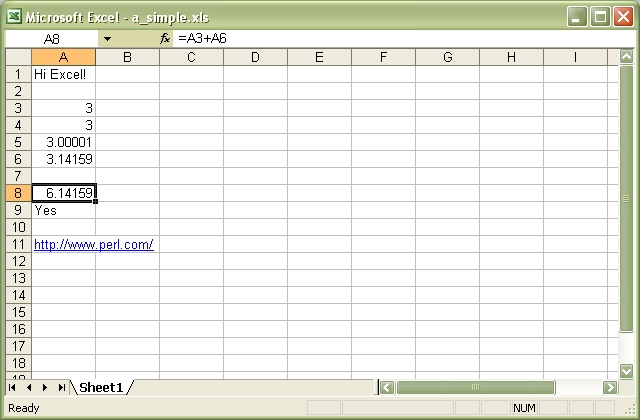
Source code for this example:
#!/usr/bin/perl -w
#######################################################################
#
# A simple example of how to use the Excel::Writer::XLSX module to
# write text and numbers to an Excel xlsx file.
#
# reverse('©'), March 2001, John McNamara, jmcnamara@cpan.org
#
use strict;
use Excel::Writer::XLSX;
# Create a new workbook called simple.xls and add a worksheet
my $workbook = Excel::Writer::XLSX->new( 'a_simple.xlsx' );
my $worksheet = $workbook->add_worksheet();
# The general syntax is write($row, $column, $token). Note that row and
# column are zero indexed
#
# Write some text
$worksheet->write( 0, 0, "Hi Excel!" );
# Write some numbers
$worksheet->write( 2, 0, 3 ); # Writes 3
$worksheet->write( 3, 0, 3.00000 ); # Writes 3
$worksheet->write( 4, 0, 3.00001 ); # Writes 3.00001
$worksheet->write( 5, 0, 3.14159 ); # TeX revision no.?
# Write some formulas
$worksheet->write( 7, 0, '=A3 + A6' );
$worksheet->write( 8, 0, '=IF(A5>3,"Yes", "No")' );
# Write a hyperlink
my $hyperlink_format = $workbook->add_format(
color => 'blue',
underline => 1,
);
$worksheet->write( 10, 0, 'http://www.perl.com/', $hyperlink_format );
__END__Download this example: http://cpansearch.perl.org/src/JMCNAMARA/Excel-Writer-XLSX-0.25/examples/a_simple.pl
Example: bug_report.pl
A template for submitting a bug report.
Run this program and read the output from the command line.
#!/usr/bin/perl -w
###############################################################################
#
# A template for submitting a bug report.
#
# Run this program and read the output from the command line.
#
# reverse('©'), March 2004, John McNamara, jmcnamara@cpan.org
#
use strict;
print << 'HINTS_1';
REPORTING A BUG OR ASKING A QUESTION
Feel free to report bugs or ask questions. However, to save time
consider the following steps first:
Read the documentation:
The Excel::Writer::XLSX documentation has been refined in
response to user questions. Therefore, if you have a question it is
possible that someone else has asked it before you and that it is
already addressed in the documentation. Since there is a lot of
documentation to get through you should at least read the table of
contents and search for keywords that you are interested in.
Look at the example programs:
There are over 40 example programs shipped with the standard
Excel::Writer::XLSX distribution. Many of these were created
in response to user questions. Try to identify an example program
that corresponds to your query and adapt it to your needs.
HINTS_1
print "Press enter ..."; <STDIN>;
print << 'HINTS_2';
If you submit a bug report here are some pointers.
1. Put "Excel::Writer::XLSX:" at the beginning of the subject line.
This helps to filter genuine messages from spam.
2. Describe the problems as clearly and as concisely as possible.
3. Send a sample program. It is often easier to describe a problem in
code than in written prose.
4. The sample program should be as small as possible to demonstrate the
problem. Don't copy and past large sections of your program. The
program should also be self contained and working.
A sample bug report is generated below. If you use this format then it
will help to analyse your question and respond to it more quickly.
Please don't send patches without contacting the author first.
HINTS_2
print "Press enter ..."; <STDIN>;
print << 'EMAIL';
=======================================================================
To: John McNamara <jmcnamara@cpan.org>
Subject: Excel::Writer::XLSX: Problem with something.
Hi John,
I am using Excel::Writer::XLSX and I have encountered a problem. I
want it to do SOMETHING but the module appears to do SOMETHING_ELSE.
Here is some code that demonstrates the problem.
#!/usr/bin/perl -w
use strict;
use Excel::Writer::XLSX;
my $workbook = Excel::Writer::XLSX->new("reload.xls");
my $worksheet = $workbook->addworksheet();
$worksheet->write(0, 0, "Hi Excel!");
__END__
My automatically generated system details are as follows:
EMAIL
print "\n Perl version : $]";
print "\n OS name : $^O";
print "\n Module versions: (not all are required)\n";
my @modules = qw(
Excel::Writer::XLSX
Spreadsheet::WriteExcel
Archive::Zip
XML::Writer
IO::File
File::Temp
);
for my $module (@modules) {
my $version;
eval "require $module";
if (not $@) {
$version = $module->VERSION;
$version = '(unknown)' if not defined $version;
}
else {
$version = '(not installed)';
}
printf "%21s%-24s\t%s\n", "", $module, $version;
}
print << "BYE";
Yours etc.,
A. Person
--
BYE
__END__Download this example: http://cpansearch.perl.org/src/JMCNAMARA/Excel-Writer-XLSX-0.25/examples/bug_report.pl
Example: demo.pl
A simple demo of some of the features of Excel::Writer::XLSX.
This program is used to create the project screenshot for Freshmeat: http://freshmeat.net/projects/writeexcel/

Source code for this example:
#!/usr/bin/perl -w
#######################################################################
#
# A simple demo of some of the features of Excel::Writer::XLSX.
#
# This program is used to create the project screenshot for Freshmeat:
# L<http://freshmeat.net/projects/writeexcel/>
#
# reverse('©'), October 2001, John McNamara, jmcnamara@cpan.org
#
use strict;
use Excel::Writer::XLSX;
my $workbook = Excel::Writer::XLSX->new( 'demo.xlsx' );
my $worksheet = $workbook->add_worksheet( 'Demo' );
my $worksheet2 = $workbook->add_worksheet( 'Another sheet' );
my $worksheet3 = $workbook->add_worksheet( 'And another' );
my $bold = $workbook->add_format( bold => 1 );
#######################################################################
#
# Write a general heading
#
$worksheet->set_column( 'A:A', 36, $bold );
$worksheet->set_column( 'B:B', 20 );
$worksheet->set_row( 0, 40 );
my $heading = $workbook->add_format(
bold => 1,
color => 'blue',
size => 16,
merge => 1,
align => 'vcenter',
);
my $hyperlink_format = $workbook->add_format(
color => 'blue',
underline => 1,
);
my @headings = ( 'Features of Excel::Writer::XLSX', '' );
$worksheet->write_row( 'A1', \@headings, $heading );
#######################################################################
#
# Some text examples
#
my $text_format = $workbook->add_format(
bold => 1,
italic => 1,
color => 'red',
size => 18,
font => 'Lucida Calligraphy'
);
$worksheet->write( 'A2', "Text" );
$worksheet->write( 'B2', "Hello Excel" );
$worksheet->write( 'A3', "Formatted text" );
$worksheet->write( 'B3', "Hello Excel", $text_format );
$worksheet->write( 'A4', "Unicode text" );
$worksheet->write( 'B4', "\x{0410} \x{0411} \x{0412} \x{0413} \x{0414}" );
#######################################################################
#
# Some numeric examples
#
my $num1_format = $workbook->add_format( num_format => '$#,##0.00' );
my $num2_format = $workbook->add_format( num_format => ' d mmmm yyy' );
$worksheet->write( 'A5', "Numbers" );
$worksheet->write( 'B5', 1234.56 );
$worksheet->write( 'A6', "Formatted numbers" );
$worksheet->write( 'B6', 1234.56, $num1_format );
$worksheet->write( 'A7', "Formatted numbers" );
$worksheet->write( 'B7', 37257, $num2_format );
#######################################################################
#
# Formulae
#
$worksheet->set_selection( 'B8' );
$worksheet->write( 'A8', 'Formulas and functions, "=SIN(PI()/4)"' );
$worksheet->write( 'B8', '=SIN(PI()/4)' );
#######################################################################
#
# Hyperlinks
#
$worksheet->write( 'A9', "Hyperlinks" );
$worksheet->write( 'B9', 'http://www.perl.com/', $hyperlink_format );
#######################################################################
#
# Images
#
# Not implemented yet.
#$worksheet->write( 'A10', "Images" );
#$worksheet->insert_image( 'B10', 'republic.png', 16, 8 );
#######################################################################
#
# Misc
#
$worksheet->write( 'A18', "Page/printer setup" );
$worksheet->write( 'A19', "Multiple worksheets" );
__END__Download this example: http://cpansearch.perl.org/src/JMCNAMARA/Excel-Writer-XLSX-0.25/examples/demo.pl
Example: formats.pl
Examples of formatting using the Excel::Writer::XLSX module.
This program demonstrates almost all possible formatting options. It is worth running this program and viewing the output Excel file if you are interested in the various formatting possibilities.
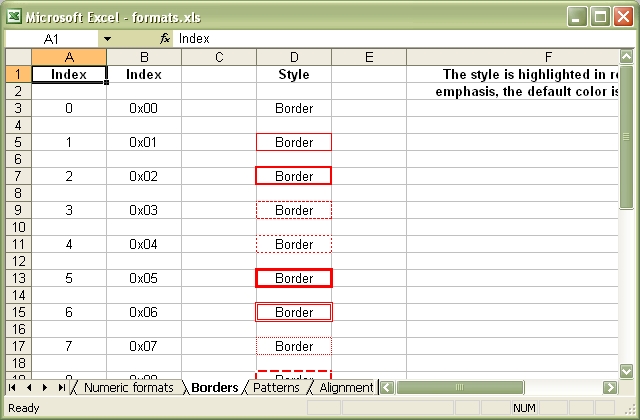
Source code for this example:
#!/usr/bin/perl -w
###############################################################################
#
# Examples of formatting using the Excel::Writer::XLSX module.
#
# This program demonstrates almost all possible formatting options. It is worth
# running this program and viewing the output Excel file if you are interested
# in the various formatting possibilities.
#
# reverse('©'), September 2002, John McNamara, jmcnamara@cpan.org
#
use strict;
use Excel::Writer::XLSX;
my $workbook = Excel::Writer::XLSX->new( 'formats.xlsx' );
# Some common formats
my $center = $workbook->add_format( align => 'center' );
my $heading = $workbook->add_format( align => 'center', bold => 1 );
# The named colors
my %colors = (
0x08, 'black',
0x0C, 'blue',
0x10, 'brown',
0x0F, 'cyan',
0x17, 'gray',
0x11, 'green',
0x0B, 'lime',
0x0E, 'magenta',
0x12, 'navy',
0x35, 'orange',
0x21, 'pink',
0x14, 'purple',
0x0A, 'red',
0x16, 'silver',
0x09, 'white',
0x0D, 'yellow',
);
# Call these subroutines to demonstrate different formatting options
intro();
fonts();
named_colors();
standard_colors();
numeric_formats();
borders();
patterns();
alignment();
misc();
# Note: this is required
$workbook->close();
######################################################################
#
# Intro.
#
sub intro {
my $worksheet = $workbook->add_worksheet( 'Introduction' );
$worksheet->set_column( 0, 0, 60 );
my $format = $workbook->add_format();
$format->set_bold();
$format->set_size( 14 );
$format->set_color( 'blue' );
$format->set_align( 'center' );
my $format2 = $workbook->add_format();
$format2->set_bold();
$format2->set_color( 'blue' );
my $format3 = $workbook->add_format(
color => 'blue',
underline => 1,
);
$worksheet->write( 2, 0, 'This workbook demonstrates some of', $format );
$worksheet->write( 3, 0, 'the formatting options provided by', $format );
$worksheet->write( 4, 0, 'the Excel::Writer::XLSX module.', $format );
$worksheet->write( 'A7', 'Sections:', $format2 );
$worksheet->write( 'A8', "internal:Fonts!A1", 'Fonts', $format3 );
$worksheet->write( 'A9', "internal:'Named colors'!A1",
'Named colors', $format3 );
$worksheet->write(
'A10',
"internal:'Standard colors'!A1",
'Standard colors', $format3
);
$worksheet->write(
'A11',
"internal:'Numeric formats'!A1",
'Numeric formats', $format3
);
$worksheet->write( 'A12', "internal:Borders!A1", 'Borders', $format3 );
$worksheet->write( 'A13', "internal:Patterns!A1", 'Patterns', $format3 );
$worksheet->write( 'A14', "internal:Alignment!A1", 'Alignment', $format3 );
$worksheet->write( 'A15', "internal:Miscellaneous!A1", 'Miscellaneous',
$format3 );
}
######################################################################
#
# Demonstrate the named colors.
#
sub named_colors {
my $worksheet = $workbook->add_worksheet( 'Named colors' );
$worksheet->set_column( 0, 3, 15 );
$worksheet->write( 0, 0, "Index", $heading );
$worksheet->write( 0, 1, "Index", $heading );
$worksheet->write( 0, 2, "Name", $heading );
$worksheet->write( 0, 3, "Color", $heading );
my $i = 1;
while ( my ( $index, $color ) = each %colors ) {
my $format = $workbook->add_format(
bg_color => $color,
pattern => 1,
border => 1
);
$worksheet->write( $i + 1, 0, $index, $center );
$worksheet->write( $i + 1, 1, sprintf( "0x%02X", $index ), $center );
$worksheet->write( $i + 1, 2, $color, $center );
$worksheet->write( $i + 1, 3, '', $format );
$i++;
}
}
######################################################################
#
# Demonstrate the standard Excel colors in the range 8..63.
#
sub standard_colors {
my $worksheet = $workbook->add_worksheet( 'Standard colors' );
$worksheet->set_column( 0, 3, 15 );
$worksheet->write( 0, 0, "Index", $heading );
$worksheet->write( 0, 1, "Index", $heading );
$worksheet->write( 0, 2, "Color", $heading );
$worksheet->write( 0, 3, "Name", $heading );
for my $i ( 8 .. 63 ) {
my $format = $workbook->add_format(
bg_color => $i,
pattern => 1,
border => 1
);
$worksheet->write( ( $i - 7 ), 0, $i, $center );
$worksheet->write( ( $i - 7 ), 1, sprintf( "0x%02X", $i ), $center );
$worksheet->write( ( $i - 7 ), 2, '', $format );
# Add the color names
if ( exists $colors{$i} ) {
$worksheet->write( ( $i - 7 ), 3, $colors{$i}, $center );
}
}
}
######################################################################
#
# Demonstrate the standard numeric formats.
#
sub numeric_formats {
my $worksheet = $workbook->add_worksheet( 'Numeric formats' );
$worksheet->set_column( 0, 4, 15 );
$worksheet->set_column( 5, 5, 45 );
$worksheet->write( 0, 0, "Index", $heading );
$worksheet->write( 0, 1, "Index", $heading );
$worksheet->write( 0, 2, "Unformatted", $heading );
$worksheet->write( 0, 3, "Formatted", $heading );
$worksheet->write( 0, 4, "Negative", $heading );
$worksheet->write( 0, 5, "Format", $heading );
#<<<
my @formats;
push @formats, [ 0x00, 1234.567, 0, 'General' ];
push @formats, [ 0x01, 1234.567, 0, '0' ];
push @formats, [ 0x02, 1234.567, 0, '0.00' ];
push @formats, [ 0x03, 1234.567, 0, '#,##0' ];
push @formats, [ 0x04, 1234.567, 0, '#,##0.00' ];
push @formats, [ 0x05, 1234.567, -1234.567, '($#,##0_);($#,##0)' ];
push @formats, [ 0x06, 1234.567, -1234.567, '($#,##0_);[Red]($#,##0)' ];
push @formats, [ 0x07, 1234.567, -1234.567, '($#,##0.00_);($#,##0.00)' ];
push @formats, [ 0x08, 1234.567, -1234.567, '($#,##0.00_);[Red]($#,##0.00)' ];
push @formats, [ 0x09, 0.567, 0, '0%' ];
push @formats, [ 0x0a, 0.567, 0, '0.00%' ];
push @formats, [ 0x0b, 1234.567, 0, '0.00E+00' ];
push @formats, [ 0x0c, 0.75, 0, '# ?/?' ];
push @formats, [ 0x0d, 0.3125, 0, '# ??/??' ];
push @formats, [ 0x0e, 36892.521, 0, 'm/d/yy' ];
push @formats, [ 0x0f, 36892.521, 0, 'd-mmm-yy' ];
push @formats, [ 0x10, 36892.521, 0, 'd-mmm' ];
push @formats, [ 0x11, 36892.521, 0, 'mmm-yy' ];
push @formats, [ 0x12, 36892.521, 0, 'h:mm AM/PM' ];
push @formats, [ 0x13, 36892.521, 0, 'h:mm:ss AM/PM' ];
push @formats, [ 0x14, 36892.521, 0, 'h:mm' ];
push @formats, [ 0x15, 36892.521, 0, 'h:mm:ss' ];
push @formats, [ 0x16, 36892.521, 0, 'm/d/yy h:mm' ];
push @formats, [ 0x25, 1234.567, -1234.567, '(#,##0_);(#,##0)' ];
push @formats, [ 0x26, 1234.567, -1234.567, '(#,##0_);[Red](#,##0)' ];
push @formats, [ 0x27, 1234.567, -1234.567, '(#,##0.00_);(#,##0.00)' ];
push @formats, [ 0x28, 1234.567, -1234.567, '(#,##0.00_);[Red](#,##0.00)' ];
push @formats, [ 0x29, 1234.567, -1234.567, '_(* #,##0_);_(* (#,##0);_(* "-"_);_(@_)' ];
push @formats, [ 0x2a, 1234.567, -1234.567, '_($* #,##0_);_($* (#,##0);_($* "-"_);_(@_)' ];
push @formats, [ 0x2b, 1234.567, -1234.567, '_(* #,##0.00_);_(* (#,##0.00);_(* "-"??_);_(@_)' ];
push @formats, [ 0x2c, 1234.567, -1234.567, '_($* #,##0.00_);_($* (#,##0.00);_($* "-"??_);_(@_)' ];
push @formats, [ 0x2d, 36892.521, 0, 'mm:ss' ];
push @formats, [ 0x2e, 3.0153, 0, '[h]:mm:ss' ];
push @formats, [ 0x2f, 36892.521, 0, 'mm:ss.0' ];
push @formats, [ 0x30, 1234.567, 0, '##0.0E+0' ];
push @formats, [ 0x31, 1234.567, 0, '@' ];
#>>>
my $i;
foreach my $format ( @formats ) {
my $style = $workbook->add_format();
$style->set_num_format( $format->[0] );
$i++;
$worksheet->write( $i, 0, $format->[0], $center );
$worksheet->write( $i, 1, sprintf( "0x%02X", $format->[0] ), $center );
$worksheet->write( $i, 2, $format->[1], $center );
$worksheet->write( $i, 3, $format->[1], $style );
if ( $format->[2] ) {
$worksheet->write( $i, 4, $format->[2], $style );
}
$worksheet->write_string( $i, 5, $format->[3] );
}
}
######################################################################
#
# Demonstrate the font options.
#
sub fonts {
my $worksheet = $workbook->add_worksheet( 'Fonts' );
$worksheet->set_column( 0, 0, 30 );
$worksheet->set_column( 1, 1, 10 );
$worksheet->write( 0, 0, "Font name", $heading );
$worksheet->write( 0, 1, "Font size", $heading );
my @fonts;
push @fonts, [ 10, 'Arial' ];
push @fonts, [ 12, 'Arial' ];
push @fonts, [ 14, 'Arial' ];
push @fonts, [ 12, 'Arial Black' ];
push @fonts, [ 12, 'Arial Narrow' ];
push @fonts, [ 12, 'Century Schoolbook' ];
push @fonts, [ 12, 'Courier' ];
push @fonts, [ 12, 'Courier New' ];
push @fonts, [ 12, 'Garamond' ];
push @fonts, [ 12, 'Impact' ];
push @fonts, [ 12, 'Lucida Handwriting' ];
push @fonts, [ 12, 'Times New Roman' ];
push @fonts, [ 12, 'Symbol' ];
push @fonts, [ 12, 'Wingdings' ];
push @fonts, [ 12, 'A font that doesn\'t exist' ];
my $i;
foreach my $font ( @fonts ) {
my $format = $workbook->add_format();
$format->set_size( $font->[0] );
$format->set_font( $font->[1] );
$i++;
$worksheet->write( $i, 0, $font->[1], $format );
$worksheet->write( $i, 1, $font->[0], $format );
}
}
######################################################################
#
# Demonstrate the standard Excel border styles.
#
sub borders {
my $worksheet = $workbook->add_worksheet( 'Borders' );
$worksheet->set_column( 0, 4, 10 );
$worksheet->set_column( 5, 5, 40 );
$worksheet->write( 0, 0, "Index", $heading );
$worksheet->write( 0, 1, "Index", $heading );
$worksheet->write( 0, 3, "Style", $heading );
$worksheet->write( 0, 5, "The style is highlighted in red for ", $heading );
$worksheet->write( 1, 5, "emphasis, the default color is black.",
$heading );
for my $i ( 0 .. 13 ) {
my $format = $workbook->add_format();
$format->set_border( $i );
$format->set_border_color( 'red' );
$format->set_align( 'center' );
$worksheet->write( ( 2 * ( $i + 1 ) ), 0, $i, $center );
$worksheet->write( ( 2 * ( $i + 1 ) ),
1, sprintf( "0x%02X", $i ), $center );
$worksheet->write( ( 2 * ( $i + 1 ) ), 3, "Border", $format );
}
$worksheet->write( 30, 0, "Diag type", $heading );
$worksheet->write( 30, 1, "Index", $heading );
$worksheet->write( 30, 3, "Style", $heading );
$worksheet->write( 30, 5, "Diagonal Boder styles", $heading );
for my $i ( 1 .. 3 ) {
my $format = $workbook->add_format();
$format->set_diag_type( $i );
$format->set_diag_border( 1 );
$format->set_diag_color( 'red' );
$format->set_align( 'center' );
$worksheet->write( ( 2 * ( $i + 15 ) ), 0, $i, $center );
$worksheet->write( ( 2 * ( $i + 15 ) ),
1, sprintf( "0x%02X", $i ), $center );
$worksheet->write( ( 2 * ( $i + 15 ) ), 3, "Border", $format );
}
}
######################################################################
#
# Demonstrate the standard Excel cell patterns.
#
sub patterns {
my $worksheet = $workbook->add_worksheet( 'Patterns' );
$worksheet->set_column( 0, 4, 10 );
$worksheet->set_column( 5, 5, 50 );
$worksheet->write( 0, 0, "Index", $heading );
$worksheet->write( 0, 1, "Index", $heading );
$worksheet->write( 0, 3, "Pattern", $heading );
$worksheet->write( 0, 5, "The background colour has been set to silver.",
$heading );
$worksheet->write( 1, 5, "The foreground colour has been set to green.",
$heading );
for my $i ( 0 .. 18 ) {
my $format = $workbook->add_format();
$format->set_pattern( $i );
$format->set_bg_color( 'silver' );
$format->set_fg_color( 'green' );
$format->set_align( 'center' );
$worksheet->write( ( 2 * ( $i + 1 ) ), 0, $i, $center );
$worksheet->write( ( 2 * ( $i + 1 ) ),
1, sprintf( "0x%02X", $i ), $center );
$worksheet->write( ( 2 * ( $i + 1 ) ), 3, "Pattern", $format );
if ( $i == 1 ) {
$worksheet->write( ( 2 * ( $i + 1 ) ),
5, "This is solid colour, the most useful pattern.", $heading );
}
}
}
######################################################################
#
# Demonstrate the standard Excel cell alignments.
#
sub alignment {
my $worksheet = $workbook->add_worksheet( 'Alignment' );
$worksheet->set_column( 0, 7, 12 );
$worksheet->set_row( 0, 40 );
$worksheet->set_selection( 7, 0 );
my $format01 = $workbook->add_format();
my $format02 = $workbook->add_format();
my $format03 = $workbook->add_format();
my $format04 = $workbook->add_format();
my $format05 = $workbook->add_format();
my $format06 = $workbook->add_format();
my $format07 = $workbook->add_format();
my $format08 = $workbook->add_format();
my $format09 = $workbook->add_format();
my $format10 = $workbook->add_format();
my $format11 = $workbook->add_format();
my $format12 = $workbook->add_format();
my $format13 = $workbook->add_format();
my $format14 = $workbook->add_format();
my $format15 = $workbook->add_format();
my $format16 = $workbook->add_format();
my $format17 = $workbook->add_format();
$format02->set_align( 'top' );
$format03->set_align( 'bottom' );
$format04->set_align( 'vcenter' );
$format05->set_align( 'vjustify' );
$format06->set_text_wrap();
$format07->set_align( 'left' );
$format08->set_align( 'right' );
$format09->set_align( 'center' );
$format10->set_align( 'fill' );
$format11->set_align( 'justify' );
$format12->set_merge();
$format13->set_rotation( 45 );
$format14->set_rotation( -45 );
$format15->set_rotation( 270 );
$format16->set_shrink();
$format17->set_indent( 1 );
$worksheet->write( 0, 0, 'Vertical', $heading );
$worksheet->write( 0, 1, 'top', $format02 );
$worksheet->write( 0, 2, 'bottom', $format03 );
$worksheet->write( 0, 3, 'vcenter', $format04 );
$worksheet->write( 0, 4, 'vjustify', $format05 );
$worksheet->write( 0, 5, "text\nwrap", $format06 );
$worksheet->write( 2, 0, 'Horizontal', $heading );
$worksheet->write( 2, 1, 'left', $format07 );
$worksheet->write( 2, 2, 'right', $format08 );
$worksheet->write( 2, 3, 'center', $format09 );
$worksheet->write( 2, 4, 'fill', $format10 );
$worksheet->write( 2, 5, 'justify', $format11 );
$worksheet->write( 3, 1, 'merge', $format12 );
$worksheet->write( 3, 2, '', $format12 );
$worksheet->write( 3, 3, 'Shrink ' x 3, $format16 );
$worksheet->write( 3, 4, 'Indent', $format17 );
$worksheet->write( 5, 0, 'Rotation', $heading );
$worksheet->write( 5, 1, 'Rotate 45', $format13 );
$worksheet->write( 6, 1, 'Rotate -45', $format14 );
$worksheet->write( 7, 1, 'Rotate 270', $format15 );
}
######################################################################
#
# Demonstrate other miscellaneous features.
#
sub misc {
my $worksheet = $workbook->add_worksheet( 'Miscellaneous' );
$worksheet->set_column( 2, 2, 25 );
my $format01 = $workbook->add_format();
my $format02 = $workbook->add_format();
my $format03 = $workbook->add_format();
my $format04 = $workbook->add_format();
my $format05 = $workbook->add_format();
my $format06 = $workbook->add_format();
my $format07 = $workbook->add_format();
$format01->set_underline( 0x01 );
$format02->set_underline( 0x02 );
$format03->set_underline( 0x21 );
$format04->set_underline( 0x22 );
$format05->set_font_strikeout();
$format06->set_font_outline();
$format07->set_font_shadow();
$worksheet->write( 1, 2, 'Underline 0x01', $format01 );
$worksheet->write( 3, 2, 'Underline 0x02', $format02 );
$worksheet->write( 5, 2, 'Underline 0x21', $format03 );
$worksheet->write( 7, 2, 'Underline 0x22', $format04 );
$worksheet->write( 9, 2, 'Strikeout', $format05 );
$worksheet->write( 11, 2, 'Outline (Macintosh only)', $format06 );
$worksheet->write( 13, 2, 'Shadow (Macintosh only)', $format07 );
}
__END__Download this example: http://cpansearch.perl.org/src/JMCNAMARA/Excel-Writer-XLSX-0.25/examples/formats.pl
Example: regions.pl
An example of how to use the Excel::Writer::XLSX module to write a basic Excel workbook with multiple worksheets.
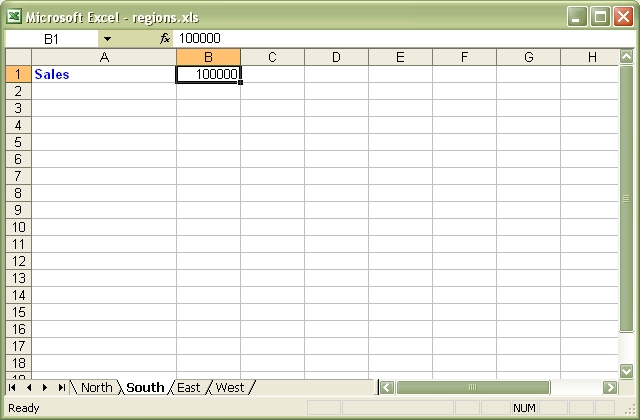
Source code for this example:
#!/usr/bin/perl -w
###############################################################################
#
# An example of how to use the Excel::Writer::XLSX module to write a basic
# Excel workbook with multiple worksheets.
#
# reverse('©'), March 2001, John McNamara, jmcnamara@cpan.org
#
use strict;
use Excel::Writer::XLSX;
# Create a new Excel workbook
my $workbook = Excel::Writer::XLSX->new( 'regions.xlsx' );
# Add some worksheets
my $north = $workbook->add_worksheet( "North" );
my $south = $workbook->add_worksheet( "South" );
my $east = $workbook->add_worksheet( "East" );
my $west = $workbook->add_worksheet( "West" );
# Add a Format
my $format = $workbook->add_format();
$format->set_bold();
$format->set_color( 'blue' );
# Add a caption to each worksheet
foreach my $worksheet ( $workbook->sheets() ) {
$worksheet->write( 0, 0, "Sales", $format );
}
# Write some data
$north->write( 0, 1, 200000 );
$south->write( 0, 1, 100000 );
$east->write( 0, 1, 150000 );
$west->write( 0, 1, 100000 );
# Set the active worksheet
$south->activate();
# Set the width of the first column
$south->set_column( 0, 0, 20 );
# Set the active cell
$south->set_selection( 0, 1 );Download this example: http://cpansearch.perl.org/src/JMCNAMARA/Excel-Writer-XLSX-0.25/examples/regions.pl
Example: stats.pl
A simple example of how to use functions with the Excel::Writer::XLSX module.
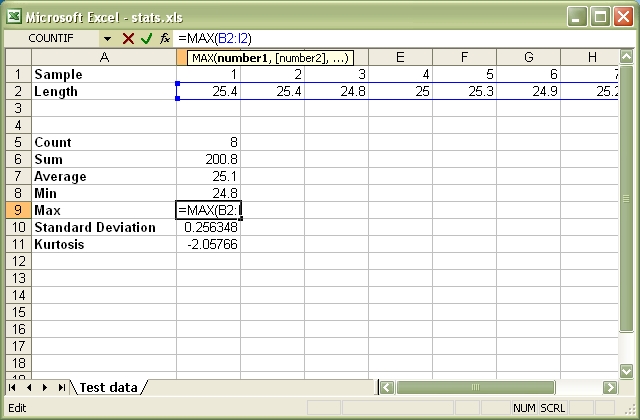
Source code for this example:
#!/usr/bin/perl -w
###############################################################################
#
# A simple example of how to use functions with the Excel::Writer::XLSX
# module.
#
# reverse('©'), March 2001, John McNamara, jmcnamara@cpan.org
#
use strict;
use Excel::Writer::XLSX;
# Create a new workbook and add a worksheet
my $workbook = Excel::Writer::XLSX->new( 'stats.xlsx' );
my $worksheet = $workbook->add_worksheet( 'Test data' );
# Set the column width for columns 1
$worksheet->set_column( 0, 0, 20 );
# Create a format for the headings
my $format = $workbook->add_format();
$format->set_bold();
# Write the sample data
$worksheet->write( 0, 0, 'Sample', $format );
$worksheet->write( 0, 1, 1 );
$worksheet->write( 0, 2, 2 );
$worksheet->write( 0, 3, 3 );
$worksheet->write( 0, 4, 4 );
$worksheet->write( 0, 5, 5 );
$worksheet->write( 0, 6, 6 );
$worksheet->write( 0, 7, 7 );
$worksheet->write( 0, 8, 8 );
$worksheet->write( 1, 0, 'Length', $format );
$worksheet->write( 1, 1, 25.4 );
$worksheet->write( 1, 2, 25.4 );
$worksheet->write( 1, 3, 24.8 );
$worksheet->write( 1, 4, 25.0 );
$worksheet->write( 1, 5, 25.3 );
$worksheet->write( 1, 6, 24.9 );
$worksheet->write( 1, 7, 25.2 );
$worksheet->write( 1, 8, 24.8 );
# Write some statistical functions
$worksheet->write( 4, 0, 'Count', $format );
$worksheet->write( 4, 1, '=COUNT(B1:I1)' );
$worksheet->write( 5, 0, 'Sum', $format );
$worksheet->write( 5, 1, '=SUM(B2:I2)' );
$worksheet->write( 6, 0, 'Average', $format );
$worksheet->write( 6, 1, '=AVERAGE(B2:I2)' );
$worksheet->write( 7, 0, 'Min', $format );
$worksheet->write( 7, 1, '=MIN(B2:I2)' );
$worksheet->write( 8, 0, 'Max', $format );
$worksheet->write( 8, 1, '=MAX(B2:I2)' );
$worksheet->write( 9, 0, 'Standard Deviation', $format );
$worksheet->write( 9, 1, '=STDEV(B2:I2)' );
$worksheet->write( 10, 0, 'Kurtosis', $format );
$worksheet->write( 10, 1, '=KURT(B2:I2)' );
__END__Download this example: http://cpansearch.perl.org/src/JMCNAMARA/Excel-Writer-XLSX-0.25/examples/stats.pl
Example: autofilter.pl
An example of how to create autofilters with Excel::Writer::XLSX.
An autofilter is a way of adding drop down lists to the headers of a 2D range of worksheet data. This is turn allow users to filter the data based on simple criteria so that some data is shown and some is hidden.
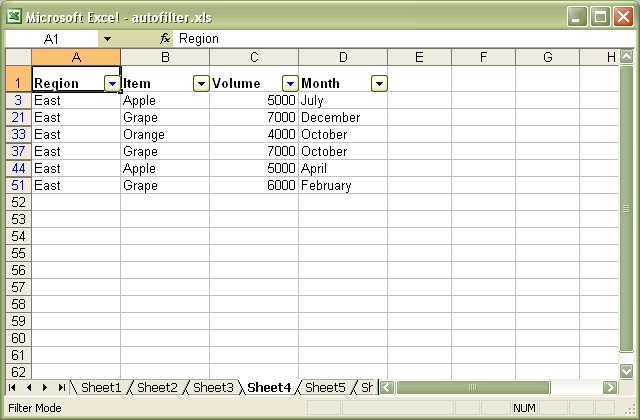
Source code for this example:
#!/usr/bin/perl
###############################################################################
#
# An example of how to create autofilters with Excel::Writer::XLSX.
#
# An autofilter is a way of adding drop down lists to the headers of a 2D range
# of worksheet data. This is turn allow users to filter the data based on
# simple criteria so that some data is shown and some is hidden.
#
# reverse('©'), September 2007, John McNamara, jmcnamara@cpan.org
#
use strict;
use warnings;
use Excel::Writer::XLSX;
my $workbook = Excel::Writer::XLSX->new( 'autofilter.xlsx' );
my $worksheet1 = $workbook->add_worksheet();
my $worksheet2 = $workbook->add_worksheet();
my $worksheet3 = $workbook->add_worksheet();
my $worksheet4 = $workbook->add_worksheet();
my $worksheet5 = $workbook->add_worksheet();
my $worksheet6 = $workbook->add_worksheet();
my $bold = $workbook->add_format( bold => 1 );
# Extract the data embedded at the end of this file.
my @headings = split ' ', <DATA>;
my @data;
push @data, [split] while <DATA>;
# Set up several sheets with the same data.
for my $worksheet ( $workbook->sheets() ) {
$worksheet->set_column( 'A:D', 12 );
$worksheet->set_row( 0, 20, $bold );
$worksheet->write( 'A1', \@headings );
}
###############################################################################
#
# Example 1. Autofilter without conditions.
#
$worksheet1->autofilter( 'A1:D51' );
$worksheet1->write( 'A2', [ [@data] ] );
###############################################################################
#
#
# Example 2. Autofilter with a filter condition in the first column.
#
# The range in this example is the same as above but in row-column notation.
$worksheet2->autofilter( 0, 0, 50, 3 );
# The placeholder "Region" in the filter is ignored and can be any string
# that adds clarity to the expression.
#
$worksheet2->filter_column( 0, 'Region eq East' );
#
# Hide the rows that don't match the filter criteria.
#
my $row = 1;
for my $row_data ( @data ) {
my $region = $row_data->[0];
if ( $region eq 'East' ) {
# Row is visible.
}
else {
# Hide row.
$worksheet2->set_row( $row, undef, undef, 1 );
}
$worksheet2->write( $row++, 0, $row_data );
}
###############################################################################
#
#
# Example 3. Autofilter with a dual filter condition in one of the columns.
#
$worksheet3->autofilter( 'A1:D51' );
$worksheet3->filter_column( 'A', 'x eq East or x eq South' );
#
# Hide the rows that don't match the filter criteria.
#
$row = 1;
for my $row_data ( @data ) {
my $region = $row_data->[0];
if ( $region eq 'East' or $region eq 'South' ) {
# Row is visible.
}
else {
# Hide row.
$worksheet3->set_row( $row, undef, undef, 1 );
}
$worksheet3->write( $row++, 0, $row_data );
}
###############################################################################
#
#
# Example 4. Autofilter with filter conditions in two columns.
#
$worksheet4->autofilter( 'A1:D51' );
$worksheet4->filter_column( 'A', 'x eq East' );
$worksheet4->filter_column( 'C', 'x > 3000 and x < 8000' );
#
# Hide the rows that don't match the filter criteria.
#
$row = 1;
for my $row_data ( @data ) {
my $region = $row_data->[0];
my $volume = $row_data->[2];
if ( $region eq 'East'
and $volume > 3000
and $volume < 8000 )
{
# Row is visible.
}
else {
# Hide row.
$worksheet4->set_row( $row, undef, undef, 1 );
}
$worksheet4->write( $row++, 0, $row_data );
}
###############################################################################
#
#
# Example 5. Autofilter with filter for blanks.
#
# Create a blank cell in our test data.
$data[5]->[0] = '';
$worksheet5->autofilter( 'A1:D51' );
$worksheet5->filter_column( 'A', 'x == Blanks' );
#
# Hide the rows that don't match the filter criteria.
#
$row = 1;
for my $row_data ( @data ) {
my $region = $row_data->[0];
if ( $region eq '' ) {
# Row is visible.
}
else {
# Hide row.
$worksheet5->set_row( $row, undef, undef, 1 );
}
$worksheet5->write( $row++, 0, $row_data );
}
###############################################################################
#
#
# Example 6. Autofilter with filter for non-blanks.
#
$worksheet6->autofilter( 'A1:D51' );
$worksheet6->filter_column( 'A', 'x == NonBlanks' );
#
# Hide the rows that don't match the filter criteria.
#
$row = 1;
for my $row_data ( @data ) {
my $region = $row_data->[0];
if ( $region ne '' ) {
# Row is visible.
}
else {
# Hide row.
$worksheet6->set_row( $row, undef, undef, 1 );
}
$worksheet6->write( $row++, 0, $row_data );
}
__DATA__
Region Item Volume Month
East Apple 9000 July
East Apple 5000 July
South Orange 9000 September
North Apple 2000 November
West Apple 9000 November
South Pear 7000 October
North Pear 9000 August
West Orange 1000 December
West Grape 1000 November
South Pear 10000 April
West Grape 6000 January
South Orange 3000 May
North Apple 3000 December
South Apple 7000 February
West Grape 1000 December
East Grape 8000 February
South Grape 10000 June
West Pear 7000 December
South Apple 2000 October
East Grape 7000 December
North Grape 6000 April
East Pear 8000 February
North Apple 7000 August
North Orange 7000 July
North Apple 6000 June
South Grape 8000 September
West Apple 3000 October
South Orange 10000 November
West Grape 4000 July
North Orange 5000 August
East Orange 1000 November
East Orange 4000 October
North Grape 5000 August
East Apple 1000 December
South Apple 10000 March
East Grape 7000 October
West Grape 1000 September
East Grape 10000 October
South Orange 8000 March
North Apple 4000 July
South Orange 5000 July
West Apple 4000 June
East Apple 5000 April
North Pear 3000 August
East Grape 9000 November
North Orange 8000 October
East Apple 10000 June
South Pear 1000 December
North Grape 10000 July
East Grape 6000 FebruaryDownload this example: http://cpansearch.perl.org/src/JMCNAMARA/Excel-Writer-XLSX-0.25/examples/autofilter.pl
Example: array_formula.pl
Example of how to use the Excel::Writer::XLSX module to write simple array formulas.
#!/usr/bin/perl
#######################################################################
#
# Example of how to use the Excel::Writer::XLSX module to write simple
# array formulas.
#
# reverse('©'), August 2004, John McNamara, jmcnamara@cpan.org
#
use strict;
use warnings;
use Excel::Writer::XLSX;
# Create a new workbook and add a worksheet
my $workbook = Excel::Writer::XLSX->new( 'array_formula.xlsx' );
my $worksheet = $workbook->add_worksheet();
# Write some test data.
$worksheet->write( 'B1', [ [ 500, 10 ], [ 300, 15 ] ] );
$worksheet->write( 'B5', [ [ 1, 2, 3 ], [ 20234, 21003, 10000 ] ] );
# Write an array formula that returns a single value
$worksheet->write( 'A1', '{=SUM(B1:C1*B2:C2)}' );
# Same as above but more verbose.
$worksheet->write_array_formula( 'A2:A2', '{=SUM(B1:C1*B2:C2)}' );
# Write an array formula that returns a range of values
$worksheet->write_array_formula( 'A5:A7', '{=TREND(C5:C7,B5:B7)}' );
__END__Download this example: http://cpansearch.perl.org/src/JMCNAMARA/Excel-Writer-XLSX-0.25/examples/array_formula.pl
Example: cgi.pl
Example of how to use the Excel::Writer::XLSX module to send an Excel file to a browser in a CGI program.
On Windows the hash-bang line should be something like:
#!C:\Perl\bin\perl.exeThe "Content-Disposition" line will cause a prompt to be generated to save the file. If you want to stream the file to the browser instead, comment out that line as shown below.
#!/usr/bin/perl -w
###############################################################################
#
# Example of how to use the Excel::Writer::XLSX module to send an Excel
# file to a browser in a CGI program.
#
# On Windows the hash-bang line should be something like:
#
# #!C:\Perl\bin\perl.exe
#
# The "Content-Disposition" line will cause a prompt to be generated to save
# the file. If you want to stream the file to the browser instead, comment out
# that line as shown below.
#
# reverse('©'), March 2001, John McNamara, jmcnamara@cpan.org
#
use strict;
use Excel::Writer::XLSX;
# Set the filename and send the content type
my $filename = "cgitest.xlsx";
print "Content-type: application/vnd.ms-excel\n";
# The Content-Disposition will generate a prompt to save the file. If you want
# to stream the file to the browser, comment out the following line.
print "Content-Disposition: attachment; filename=$filename\n";
print "\n";
# Create a new workbook and add a worksheet. The special Perl filehandle - will
# redirect the output to STDOUT
#
my $workbook = Excel::Writer::XLSX->new( "-" );
my $worksheet = $workbook->add_worksheet();
# Set the column width for column 1
$worksheet->set_column( 0, 0, 20 );
# Create a format
my $format = $workbook->add_format();
$format->set_bold();
$format->set_size( 15 );
$format->set_color( 'blue' );
# Write to the workbook
$worksheet->write( 0, 0, "Hi Excel!", $format );
__END__Download this example: http://cpansearch.perl.org/src/JMCNAMARA/Excel-Writer-XLSX-0.25/examples/cgi.pl
Example: chart_area.pl
A demo of an Area chart in Excel::Writer::XLSX.
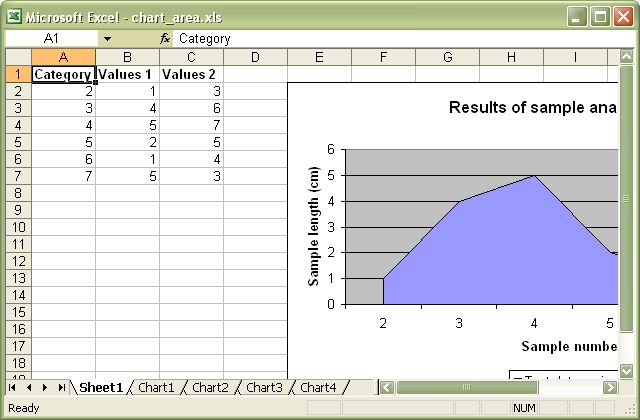
Source code for this example:
#!/usr/bin/perl -w
#######################################################################
#
# A demo of an Area chart in Excel::Writer::XLSX.
#
# reverse('©'), March 2011, John McNamara, jmcnamara@cpan.org
#
use strict;
use warnings;
use Excel::Writer::XLSX;
my $workbook = Excel::Writer::XLSX->new( 'chart_area.xlsx' );
my $worksheet = $workbook->add_worksheet();
my $bold = $workbook->add_format( bold => 1 );
# Add the worksheet data that the charts will refer to.
my $headings = [ 'Number', 'Batch 1', 'Batch 2' ];
my $data = [
[ 2, 3, 4, 5, 6, 7 ],
[ 40, 40, 50, 30, 25, 50 ],
[ 30, 25, 30, 10, 5, 10 ],
];
$worksheet->write( 'A1', $headings, $bold );
$worksheet->write( 'A2', $data );
# Create a new chart object. In this case an embedded chart.
my $chart = $workbook->add_chart( type => 'area', embedded => 1 );
# Configure the first series.
$chart->add_series(
name => '=Sheet1!$B$1',
categories => '=Sheet1!$A$2:$A$7',
values => '=Sheet1!$B$2:$B$7',
);
# Configure second series. Note alternative use of array ref to define
# ranges: [ $sheetname, $row_start, $row_end, $col_start, $col_end ].
$chart->add_series(
name => '=Sheet1!$C$1',
categories => [ 'Sheet1', 1, 6, 0, 0 ],
values => [ 'Sheet1', 1, 6, 2, 2 ],
);
# Add a chart title and some axis labels.
$chart->set_title ( name => 'Results of sample analysis' );
$chart->set_x_axis( name => 'Test number' );
$chart->set_y_axis( name => 'Sample length (mm)' );
# Set an Excel chart style. Blue colors with white outline and shadow.
$chart->set_style( 11 );
# Insert the chart into the worksheet (with an offset).
$worksheet->insert_chart( 'D2', $chart, 25, 10 );
__END__Download this example: http://cpansearch.perl.org/src/JMCNAMARA/Excel-Writer-XLSX-0.25/examples/chart_area.pl
Example: chart_bar.pl
A demo of a Bar chart in Excel::Writer::XLSX.
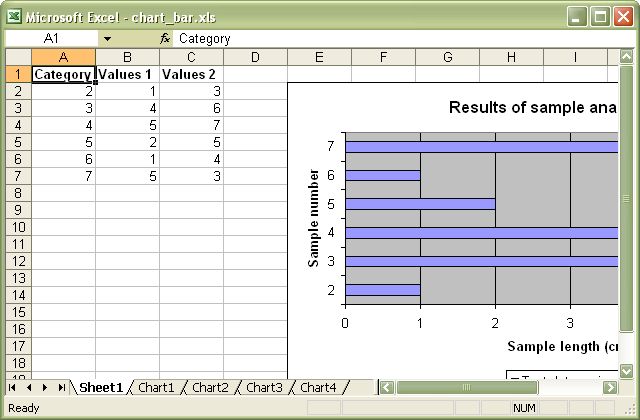
Source code for this example:
#!/usr/bin/perl
#######################################################################
#
# A demo of a Bar chart in Excel::Writer::XLSX.
#
# reverse('©'), March 2011, John McNamara, jmcnamara@cpan.org
#
use strict;
use warnings;
use Excel::Writer::XLSX;
my $workbook = Excel::Writer::XLSX->new( 'chart_bar.xlsx' );
my $worksheet = $workbook->add_worksheet();
my $bold = $workbook->add_format( bold => 1 );
# Add the worksheet data that the charts will refer to.
my $headings = [ 'Number', 'Batch 1', 'Batch 2' ];
my $data = [
[ 2, 3, 4, 5, 6, 7 ],
[ 10, 40, 50, 20, 10, 50 ],
[ 30, 60, 70, 50, 40, 30 ],
];
$worksheet->write( 'A1', $headings, $bold );
$worksheet->write( 'A2', $data );
# Create a new chart object. In this case an embedded chart.
my $chart = $workbook->add_chart( type => 'bar', embedded => 1 );
# Configure the first series.
$chart->add_series(
name => '=Sheet1!$B$1',
categories => '=Sheet1!$A$2:$A$7',
values => '=Sheet1!$B$2:$B$7',
);
# Configure second series. Note alternative use of array ref to define
# ranges: [ $sheetname, $row_start, $row_end, $col_start, $col_end ].
$chart->add_series(
name => '=Sheet1!$C$1',
categories => [ 'Sheet1', 1, 6, 0, 0 ],
values => [ 'Sheet1', 1, 6, 2, 2 ],
);
# Add a chart title and some axis labels.
$chart->set_title ( name => 'Results of sample analysis' );
$chart->set_x_axis( name => 'Test number' );
$chart->set_y_axis( name => 'Sample length (mm)' );
# Set an Excel chart style. Blue colors with white outline and shadow.
$chart->set_style( 11 );
# Insert the chart into the worksheet (with an offset).
$worksheet->insert_chart( 'D2', $chart, 25, 10 );
__END__Download this example: http://cpansearch.perl.org/src/JMCNAMARA/Excel-Writer-XLSX-0.25/examples/chart_bar.pl
Example: chart_column.pl
A demo of a Column chart in Excel::Writer::XLSX.
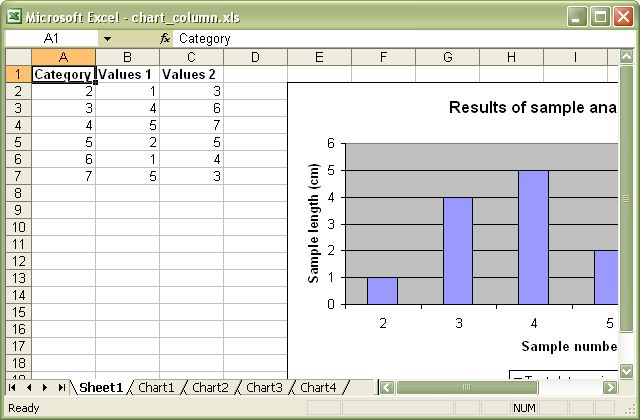
Source code for this example:
#!/usr/bin/perl
#######################################################################
#
# A demo of a Column chart in Excel::Writer::XLSX.
#
# reverse('©'), March 2011, John McNamara, jmcnamara@cpan.org
#
use strict;
use warnings;
use Excel::Writer::XLSX;
my $workbook = Excel::Writer::XLSX->new( 'chart_column.xlsx' );
my $worksheet = $workbook->add_worksheet();
my $bold = $workbook->add_format( bold => 1 );
# Add the worksheet data that the charts will refer to.
my $headings = [ 'Number', 'Batch 1', 'Batch 2' ];
my $data = [
[ 2, 3, 4, 5, 6, 7 ],
[ 10, 40, 50, 20, 10, 50 ],
[ 30, 60, 70, 50, 40, 30 ],
];
$worksheet->write( 'A1', $headings, $bold );
$worksheet->write( 'A2', $data );
# Create a new chart object. In this case an embedded chart.
my $chart = $workbook->add_chart( type => 'column', embedded => 1 );
# Configure the first series.
$chart->add_series(
name => '=Sheet1!$B$1',
categories => '=Sheet1!$A$2:$A$7',
values => '=Sheet1!$B$2:$B$7',
);
# Configure second series. Note alternative use of array ref to define
# ranges: [ $sheetname, $row_start, $row_end, $col_start, $col_end ].
$chart->add_series(
name => '=Sheet1!$C$1',
categories => [ 'Sheet1', 1, 6, 0, 0 ],
values => [ 'Sheet1', 1, 6, 2, 2 ],
);
# Add a chart title and some axis labels.
$chart->set_title ( name => 'Results of sample analysis' );
$chart->set_x_axis( name => 'Test number' );
$chart->set_y_axis( name => 'Sample length (mm)' );
# Set an Excel chart style. Blue colors with white outline and shadow.
$chart->set_style( 11 );
# Insert the chart into the worksheet (with an offset).
$worksheet->insert_chart( 'D2', $chart, 25, 10 );
__END__Download this example: http://cpansearch.perl.org/src/JMCNAMARA/Excel-Writer-XLSX-0.25/examples/chart_column.pl
Example: chart_line.pl
A demo of a Line chart in Excel::Writer::XLSX.
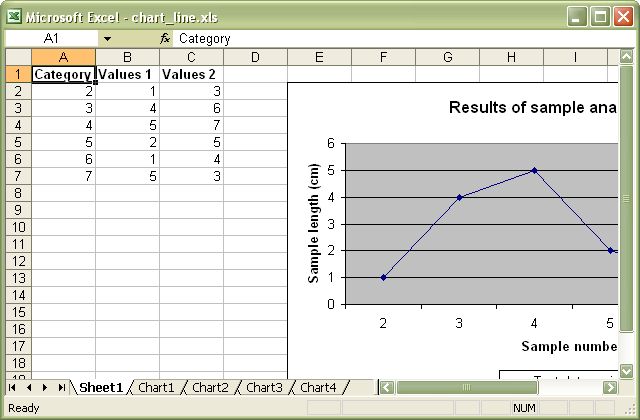
Source code for this example:
#!/usr/bin/perl
#######################################################################
#
# A demo of a Line chart in Excel::Writer::XLSX.
#
# reverse('©'), March 2011, John McNamara, jmcnamara@cpan.org
#
use strict;
use warnings;
use Excel::Writer::XLSX;
my $workbook = Excel::Writer::XLSX->new( 'chart_line.xlsx' );
my $worksheet = $workbook->add_worksheet();
my $bold = $workbook->add_format( bold => 1 );
# Add the worksheet data that the charts will refer to.
my $headings = [ 'Number', 'Batch 1', 'Batch 2' ];
my $data = [
[ 2, 3, 4, 5, 6, 7 ],
[ 10, 40, 50, 20, 10, 50 ],
[ 30, 60, 70, 50, 40, 30 ],
];
$worksheet->write( 'A1', $headings, $bold );
$worksheet->write( 'A2', $data );
# Create a new chart object. In this case an embedded chart.
my $chart = $workbook->add_chart( type => 'line', embedded => 1 );
# Configure the first series.
$chart->add_series(
name => '=Sheet1!$B$1',
categories => '=Sheet1!$A$2:$A$7',
values => '=Sheet1!$B$2:$B$7',
);
# Configure second series. Note alternative use of array ref to define
# ranges: [ $sheetname, $row_start, $row_end, $col_start, $col_end ].
$chart->add_series(
name => '=Sheet1!$C$1',
categories => [ 'Sheet1', 1, 6, 0, 0 ],
values => [ 'Sheet1', 1, 6, 2, 2 ],
);
# Add a chart title and some axis labels.
$chart->set_title ( name => 'Results of sample analysis' );
$chart->set_x_axis( name => 'Test number' );
$chart->set_y_axis( name => 'Sample length (mm)' );
# Set an Excel chart style. Colors with white outline and shadow.
$chart->set_style( 10 );
# Insert the chart into the worksheet (with an offset).
$worksheet->insert_chart( 'D2', $chart, 25, 10 );
__END__Download this example: http://cpansearch.perl.org/src/JMCNAMARA/Excel-Writer-XLSX-0.25/examples/chart_line.pl
Example: chart_pie.pl
A demo of a Pie chart in Excel::Writer::XLSX.
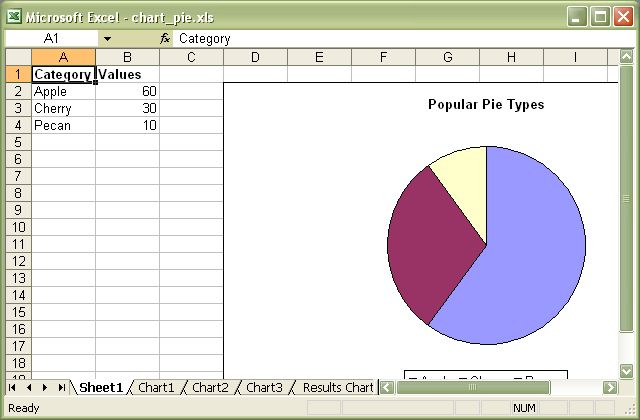
Source code for this example:
#!/usr/bin/perl
#######################################################################
#
# A demo of a Pie chart in Excel::Writer::XLSX.
#
# reverse('©'), March 2011, John McNamara, jmcnamara@cpan.org
#
use strict;
use warnings;
use Excel::Writer::XLSX;
my $workbook = Excel::Writer::XLSX->new( 'chart_pie.xlsx' );
my $worksheet = $workbook->add_worksheet();
my $bold = $workbook->add_format( bold => 1 );
# Add the worksheet data that the charts will refer to.
my $headings = [ 'Category', 'Values' ];
my $data = [
[ 'Apple', 'Cherry', 'Pecan' ],
[ 60, 30, 10 ],
];
$worksheet->write( 'A1', $headings, $bold );
$worksheet->write( 'A2', $data );
# Create a new chart object. In this case an embedded chart.
my $chart = $workbook->add_chart( type => 'pie', embedded => 1 );
# Configure the series. Note the use of the array ref to define ranges:
# [ $sheetname, $row_start, $row_end, $col_start, $col_end ].
$chart->add_series(
name => 'Pie sales data',
categories => [ 'Sheet1', 1, 3, 0, 0 ],
values => [ 'Sheet1', 1, 3, 1, 1 ],
);
# Add a title.
$chart->set_title( name => 'Popular Pie Types' );
# Set an Excel chart style. Colors with white outline and shadow.
$chart->set_style( 10 );
# Insert the chart into the worksheet (with an offset).
$worksheet->insert_chart( 'C2', $chart, 25, 10 );
__END__Download this example: http://cpansearch.perl.org/src/JMCNAMARA/Excel-Writer-XLSX-0.25/examples/chart_pie.pl
Example: chart_scatter.pl
A demo of a Scatter chart in Excel::Writer::XLSX.
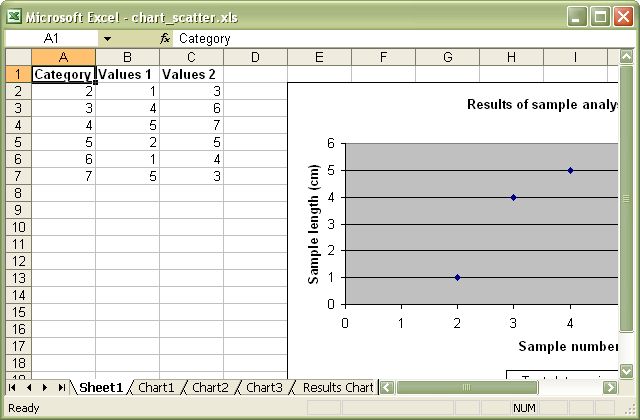
Source code for this example:
#!/usr/bin/perl
#######################################################################
#
# A demo of a Scatter chart in Excel::Writer::XLSX.
#
# reverse('©'), March 2011, John McNamara, jmcnamara@cpan.org
#
use strict;
use warnings;
use Excel::Writer::XLSX;
my $workbook = Excel::Writer::XLSX->new( 'chart_scatter.xlsx' );
my $worksheet = $workbook->add_worksheet();
my $bold = $workbook->add_format( bold => 1 );
# Add the worksheet data that the charts will refer to.
my $headings = [ 'Number', 'Batch 1', 'Batch 2' ];
my $data = [
[ 2, 3, 4, 5, 6, 7 ],
[ 10, 40, 50, 20, 10, 50 ],
[ 30, 60, 70, 50, 40, 30 ],
];
$worksheet->write( 'A1', $headings, $bold );
$worksheet->write( 'A2', $data );
# Create a new chart object. In this case an embedded chart.
my $chart = $workbook->add_chart( type => 'scatter', embedded => 1 );
# Configure the first series.
$chart->add_series(
name => '=Sheet1!$B$1',
categories => '=Sheet1!$A$2:$A$7',
values => '=Sheet1!$B$2:$B$7',
);
# Configure second series. Note alternative use of array ref to define
# ranges: [ $sheetname, $row_start, $row_end, $col_start, $col_end ].
$chart->add_series(
name => '=Sheet1!$C$1',
categories => [ 'Sheet1', 1, 6, 0, 0 ],
values => [ 'Sheet1', 1, 6, 2, 2 ],
);
# Add a chart title and some axis labels.
$chart->set_title ( name => 'Results of sample analysis' );
$chart->set_x_axis( name => 'Test number' );
$chart->set_y_axis( name => 'Sample length (mm)' );
# Set an Excel chart style. Colors with white outline and shadow.
$chart->set_style( 10 );
# Insert the chart into the worksheet (with an offset).
$worksheet->insert_chart( 'D2', $chart, 25, 10 );
__END__Download this example: http://cpansearch.perl.org/src/JMCNAMARA/Excel-Writer-XLSX-0.25/examples/chart_scatter.pl
Example: chart_stock.pl
A demo of a Stock chart in Excel::Writer::XLSX.
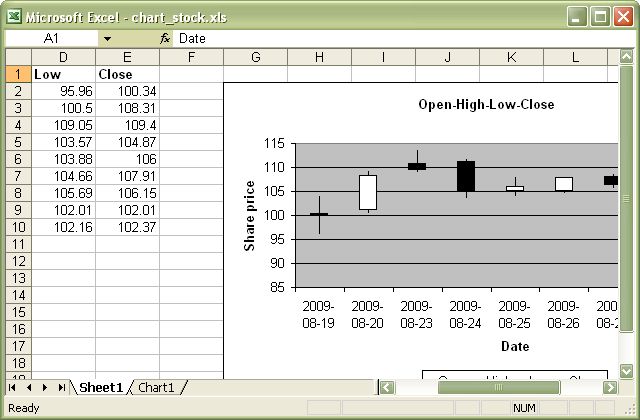
Source code for this example:
#!/usr/bin/perl
#######################################################################
#
# A demo of a Stock chart in Excel::Writer::XLSX.
#
# reverse('©'), March 2011, John McNamara, jmcnamara@cpan.org
#
use strict;
use warnings;
use Excel::Writer::XLSX;
use Excel::Writer::XLSX;
my $workbook = Excel::Writer::XLSX->new( 'chart_stock.xlsx' );
my $worksheet = $workbook->add_worksheet();
my $bold = $workbook->add_format( bold => 1 );
my $date_format = $workbook->add_format( num_format => 'dd/mm/yyyy' );
my $chart = $workbook->add_chart( type => 'stock', embedded => 1 );
# Add the worksheet data that the charts will refer to.
my $headings = [ 'Date', 'High', 'Low', 'Close' ];
my $data = [
[ '2007-01-01T', '2007-01-02T', '2007-01-03T', '2007-01-04T', '2007-01-05T' ],
[ 27.2, 25.03, 19.05, 20.34, 18.5 ],
[ 23.49, 19.55, 15.12, 17.84, 16.34 ],
[ 25.45, 23.05, 17.32, 20.45, 17.34 ],
];
$worksheet->write( 'A1', $headings, $bold );
for my $row ( 0 .. 4 ) {
$worksheet->write_date_time( $row+1, 0, $data->[0]->[$row], $date_format );
$worksheet->write( $row+1, 1, $data->[1]->[$row] );
$worksheet->write( $row+1, 2, $data->[2]->[$row] );
$worksheet->write( $row+1, 3, $data->[3]->[$row] );
}
$worksheet->set_column( 'A:D', 11 );
# Add a series for each of the High-Low-Close columns.
$chart->add_series(
categories => '=Sheet1!$A$2:$A$6',
values => '=Sheet1!$B$2:$B$6',
);
$chart->add_series(
categories => '=Sheet1!$A$2:$A$6',
values => '=Sheet1!$C$2:$C$6',
);
$chart->add_series(
categories => '=Sheet1!$A$2:$A$6',
values => '=Sheet1!$D$2:$D$6',
);
# Add a chart title and some axis labels.
$chart->set_title ( name => 'High-Low-Close', );
$chart->set_x_axis( name => 'Date', );
$chart->set_y_axis( name => 'Share price', );
$worksheet->insert_chart( 'E9', $chart );
__END__Download this example: http://cpansearch.perl.org/src/JMCNAMARA/Excel-Writer-XLSX-0.25/examples/chart_stock.pl
Example: colors.pl
Demonstrates Excel::Writer::XLSX's named colors and the Excel color palette.
The set_custom_color() Worksheet method can be used to override one of the built-in palette values with a more suitable colour. See the main docs.

Source code for this example:
#!/usr/bin/perl -w
################################################################################
#
# Demonstrates Excel::Writer::XLSX's named colors and the Excel color
# palette.
#
# The set_custom_color() Worksheet method can be used to override one of the
# built-in palette values with a more suitable colour. See the main docs.
#
# reverse('©'), March 2002, John McNamara, jmcnamara@cpan.org
#
use strict;
use Excel::Writer::XLSX;
my $workbook = Excel::Writer::XLSX->new( 'colors.xlsx' );
# Some common formats
my $center = $workbook->add_format( align => 'center' );
my $heading = $workbook->add_format( align => 'center', bold => 1 );
######################################################################
#
# Demonstrate the named colors.
#
my %colors = (
0x08, 'black',
0x0C, 'blue',
0x10, 'brown',
0x0F, 'cyan',
0x17, 'gray',
0x11, 'green',
0x0B, 'lime',
0x0E, 'magenta',
0x12, 'navy',
0x35, 'orange',
0x21, 'pink',
0x14, 'purple',
0x0A, 'red',
0x16, 'silver',
0x09, 'white',
0x0D, 'yellow',
);
my $worksheet1 = $workbook->add_worksheet( 'Named colors' );
$worksheet1->set_column( 0, 3, 15 );
$worksheet1->write( 0, 0, "Index", $heading );
$worksheet1->write( 0, 1, "Index", $heading );
$worksheet1->write( 0, 2, "Name", $heading );
$worksheet1->write( 0, 3, "Color", $heading );
my $i = 1;
while ( my ( $index, $color ) = each %colors ) {
my $format = $workbook->add_format(
fg_color => $color,
pattern => 1,
border => 1
);
$worksheet1->write( $i + 1, 0, $index, $center );
$worksheet1->write( $i + 1, 1, sprintf( "0x%02X", $index ), $center );
$worksheet1->write( $i + 1, 2, $color, $center );
$worksheet1->write( $i + 1, 3, '', $format );
$i++;
}
######################################################################
#
# Demonstrate the standard Excel colors in the range 8..63.
#
my $worksheet2 = $workbook->add_worksheet( 'Standard colors' );
$worksheet2->set_column( 0, 3, 15 );
$worksheet2->write( 0, 0, "Index", $heading );
$worksheet2->write( 0, 1, "Index", $heading );
$worksheet2->write( 0, 2, "Color", $heading );
$worksheet2->write( 0, 3, "Name", $heading );
for my $i ( 8 .. 63 ) {
my $format = $workbook->add_format(
fg_color => $i,
pattern => 1,
border => 1
);
$worksheet2->write( ( $i - 7 ), 0, $i, $center );
$worksheet2->write( ( $i - 7 ), 1, sprintf( "0x%02X", $i ), $center );
$worksheet2->write( ( $i - 7 ), 2, '', $format );
# Add the color names
if ( exists $colors{$i} ) {
$worksheet2->write( ( $i - 7 ), 3, $colors{$i}, $center );
}
}
__END__Download this example: http://cpansearch.perl.org/src/JMCNAMARA/Excel-Writer-XLSX-0.25/examples/colors.pl
Example: data_validate.pl
Example of how to add data validation and dropdown lists to an Excel::Writer::XLSX file.
Data validation is a feature of Excel which allows you to restrict the data that a users enters in a cell and to display help and warning messages. It also allows you to restrict input to values in a drop down list.
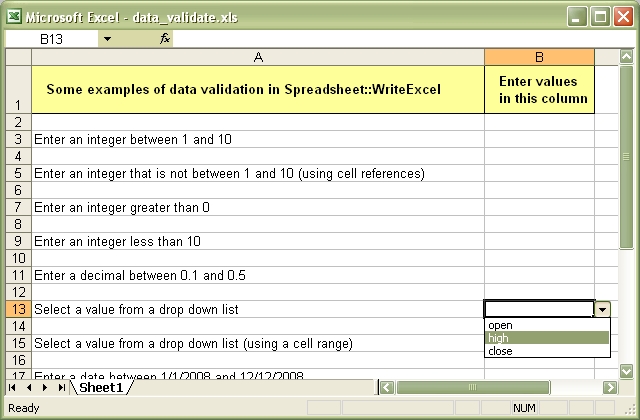
Source code for this example:
#!/usr/bin/perl
###############################################################################
#
# Example of how to add data validation and dropdown lists to an
# Excel::Writer::XLSX file.
#
# Data validation is a feature of Excel which allows you to restrict the data
# that a users enters in a cell and to display help and warning messages. It
# also allows you to restrict input to values in a drop down list.
#
# reverse('©'), August 2008, John McNamara, jmcnamara@cpan.org
#
use strict;
use warnings;
use Excel::Writer::XLSX;
my $workbook = Excel::Writer::XLSX->new( 'data_validate.xlsx' );
my $worksheet = $workbook->add_worksheet();
# Add a format for the header cells.
my $header_format = $workbook->add_format(
border => 1,
bg_color => 43,
bold => 1,
text_wrap => 1,
valign => 'vcenter',
indent => 1,
);
# Set up layout of the worksheet.
$worksheet->set_column( 'A:A', 68 );
$worksheet->set_column( 'B:B', 15 );
$worksheet->set_column( 'D:D', 15 );
$worksheet->set_row( 0, 36 );
$worksheet->set_selection( 'B3' );
# Write the header cells and some data that will be used in the examples.
my $row = 0;
my $txt;
my $heading1 = 'Some examples of data validation in Excel::Writer::XLSX';
my $heading2 = 'Enter values in this column';
my $heading3 = 'Sample Data';
$worksheet->write( 'A1', $heading1, $header_format );
$worksheet->write( 'B1', $heading2, $header_format );
$worksheet->write( 'D1', $heading3, $header_format );
$worksheet->write( 'D3', [ 'Integers', 1, 10 ] );
$worksheet->write( 'D4', [ 'List data', 'open', 'high', 'close' ] );
$worksheet->write( 'D5', [ 'Formula', '=AND(F5=50,G5=60)', 50, 60 ] );
#
# Example 1. Limiting input to an integer in a fixed range.
#
$txt = 'Enter an integer between 1 and 10';
$row += 2;
$worksheet->write( $row, 0, $txt );
$worksheet->data_validation(
$row, 1,
{
validate => 'integer',
criteria => 'between',
minimum => 1,
maximum => 10,
}
);
#
# Example 2. Limiting input to an integer outside a fixed range.
#
$txt = 'Enter an integer that is not between 1 and 10 (using cell references)';
$row += 2;
$worksheet->write( $row, 0, $txt );
$worksheet->data_validation(
$row, 1,
{
validate => 'integer',
criteria => 'not between',
minimum => '=E3',
maximum => '=F3',
}
);
#
# Example 3. Limiting input to an integer greater than a fixed value.
#
$txt = 'Enter an integer greater than 0';
$row += 2;
$worksheet->write( $row, 0, $txt );
$worksheet->data_validation(
$row, 1,
{
validate => 'integer',
criteria => '>',
value => 0,
}
);
#
# Example 4. Limiting input to an integer less than a fixed value.
#
$txt = 'Enter an integer less than 10';
$row += 2;
$worksheet->write( $row, 0, $txt );
$worksheet->data_validation(
$row, 1,
{
validate => 'integer',
criteria => '<',
value => 10,
}
);
#
# Example 5. Limiting input to a decimal in a fixed range.
#
$txt = 'Enter a decimal between 0.1 and 0.5';
$row += 2;
$worksheet->write( $row, 0, $txt );
$worksheet->data_validation(
$row, 1,
{
validate => 'decimal',
criteria => 'between',
minimum => 0.1,
maximum => 0.5,
}
);
#
# Example 6. Limiting input to a value in a dropdown list.
#
$txt = 'Select a value from a drop down list';
$row += 2;
$worksheet->write( $row, 0, $txt );
$worksheet->data_validation(
$row, 1,
{
validate => 'list',
source => [ 'open', 'high', 'close' ],
}
);
#
# Example 6. Limiting input to a value in a dropdown list.
#
$txt = 'Select a value from a drop down list (using a cell range)';
$row += 2;
$worksheet->write( $row, 0, $txt );
$worksheet->data_validation(
$row, 1,
{
validate => 'list',
source => '=E4:G4',
}
);
#
# Example 7. Limiting input to a date in a fixed range.
#
$txt = 'Enter a date between 1/1/2008 and 12/12/2008';
$row += 2;
$worksheet->write( $row, 0, $txt );
$worksheet->data_validation(
$row, 1,
{
validate => 'date',
criteria => 'between',
minimum => '2008-01-01T',
maximum => '2008-12-12T',
}
);
#
# Example 8. Limiting input to a time in a fixed range.
#
$txt = 'Enter a time between 6:00 and 12:00';
$row += 2;
$worksheet->write( $row, 0, $txt );
$worksheet->data_validation(
$row, 1,
{
validate => 'time',
criteria => 'between',
minimum => 'T06:00',
maximum => 'T12:00',
}
);
#
# Example 9. Limiting input to a string greater than a fixed length.
#
$txt = 'Enter a string longer than 3 characters';
$row += 2;
$worksheet->write( $row, 0, $txt );
$worksheet->data_validation(
$row, 1,
{
validate => 'length',
criteria => '>',
value => 3,
}
);
#
# Example 10. Limiting input based on a formula.
#
$txt = 'Enter a value if the following is true "=AND(F5=50,G5=60)"';
$row += 2;
$worksheet->write( $row, 0, $txt );
$worksheet->data_validation(
$row, 1,
{
validate => 'custom',
value => '=AND(F5=50,G5=60)',
}
);
#
# Example 11. Displaying and modify data validation messages.
#
$txt = 'Displays a message when you select the cell';
$row += 2;
$worksheet->write( $row, 0, $txt );
$worksheet->data_validation(
$row, 1,
{
validate => 'integer',
criteria => 'between',
minimum => 1,
maximum => 100,
input_title => 'Enter an integer:',
input_message => 'between 1 and 100',
}
);
#
# Example 12. Displaying and modify data validation messages.
#
$txt = 'Display a custom error message when integer isn\'t between 1 and 100';
$row += 2;
$worksheet->write( $row, 0, $txt );
$worksheet->data_validation(
$row, 1,
{
validate => 'integer',
criteria => 'between',
minimum => 1,
maximum => 100,
input_title => 'Enter an integer:',
input_message => 'between 1 and 100',
error_title => 'Input value is not valid!',
error_message => 'It should be an integer between 1 and 100',
}
);
#
# Example 13. Displaying and modify data validation messages.
#
$txt =
'Display a custom information message when integer isn\'t between 1 and 100';
$row += 2;
$worksheet->write( $row, 0, $txt );
$worksheet->data_validation(
$row, 1,
{
validate => 'integer',
criteria => 'between',
minimum => 1,
maximum => 100,
input_title => 'Enter an integer:',
input_message => 'between 1 and 100',
error_title => 'Input value is not valid!',
error_message => 'It should be an integer between 1 and 100',
error_type => 'information',
}
);
__END__Download this example: http://cpansearch.perl.org/src/JMCNAMARA/Excel-Writer-XLSX-0.25/examples/data_validate.pl
Example: date_time.pl
Excel::Writer::XLSX example of writing dates and times using the write_date_time() Worksheet method.
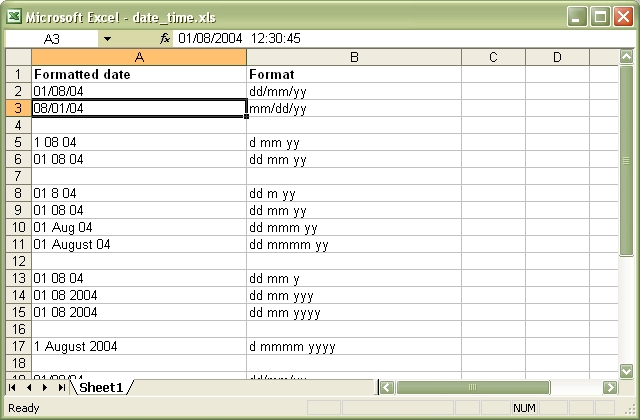
Source code for this example:
#!/usr/bin/perl
###############################################################################
#
# Excel::Writer::XLSX example of writing dates and times using the
# write_date_time() Worksheet method.
#
# reverse('©'), August 2004, John McNamara, jmcnamara@cpan.org
#
use strict;
use warnings;
use Excel::Writer::XLSX;
# Create a new workbook and add a worksheet
my $workbook = Excel::Writer::XLSX->new( 'date_time.xlsx' );
my $worksheet = $workbook->add_worksheet();
my $bold = $workbook->add_format( bold => 1 );
# Expand the first column so that the date is visible.
$worksheet->set_column( "A:B", 30 );
# Write the column headers
$worksheet->write( 'A1', 'Formatted date', $bold );
$worksheet->write( 'B1', 'Format', $bold );
# Examples date and time formats. In the output file compare how changing
# the format codes change the appearance of the date.
#
my @date_formats = (
'dd/mm/yy',
'mm/dd/yy',
'',
'd mm yy',
'dd mm yy',
'',
'dd m yy',
'dd mm yy',
'dd mmm yy',
'dd mmmm yy',
'',
'dd mm y',
'dd mm yyy',
'dd mm yyyy',
'',
'd mmmm yyyy',
'',
'dd/mm/yy',
'dd/mm/yy hh:mm',
'dd/mm/yy hh:mm:ss',
'dd/mm/yy hh:mm:ss.000',
'',
'hh:mm',
'hh:mm:ss',
'hh:mm:ss.000',
);
# Write the same date and time using each of the above formats. The empty
# string formats create a blank line to make the example clearer.
#
my $row = 0;
for my $date_format ( @date_formats ) {
$row++;
next if $date_format eq '';
# Create a format for the date or time.
my $format = $workbook->add_format(
num_format => $date_format,
align => 'left'
);
# Write the same date using different formats.
$worksheet->write_date_time( $row, 0, '2004-08-01T12:30:45.123', $format );
$worksheet->write( $row, 1, $date_format );
}
# The following is an example of an invalid date. It is written as a string
# instead of a number. This is also Excel's default behaviour.
#
$row += 2;
$worksheet->write_date_time( $row, 0, '2004-13-01T12:30:45.123' );
$worksheet->write( $row, 1, 'Invalid date. Written as string.', $bold );
__END__Download this example: http://cpansearch.perl.org/src/JMCNAMARA/Excel-Writer-XLSX-0.25/examples/date_time.pl
Example: defined_name.pl
Example of how to create defined names in a Excel::Writer::XLSX file.
This method is used to define a user friendly name to represent a value, a single cell or a range of cells in a workbook.
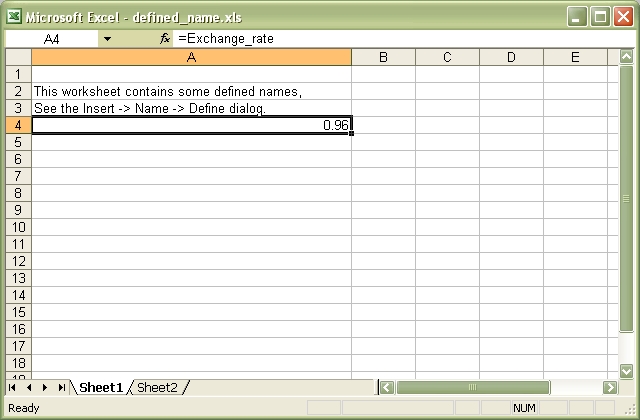
Source code for this example:
#!/usr/bin/perl
##############################################################################
#
# Example of how to create defined names in a Excel::Writer::XLSX file.
#
# This method is used to define a user friendly name to represent a value,
# a single cell or a range of cells in a workbook.
#
# reverse('©'), September 2008, John McNamara, jmcnamara@cpan.org
#
use strict;
use warnings;
use Excel::Writer::XLSX;
my $workbook = Excel::Writer::XLSX->new( 'defined_name.xlsx' );
my $worksheet1 = $workbook->add_worksheet();
my $worksheet2 = $workbook->add_worksheet();
# Define some global/workbook names.
$workbook->define_name( 'Exchange_rate', '=0.96' );
$workbook->define_name( 'Sales', '=Sheet1!$G$1:$H$10' );
# Define a local/worksheet name.
$workbook->define_name( 'Sheet2!Sales', '=Sheet2!$G$1:$G$10' );
# Write some text in the file and one of the defined names in a formula.
for my $worksheet ( $workbook->sheets() ) {
$worksheet->set_column( 'A:A', 45 );
$worksheet->write( 'A1', 'This worksheet contains some defined names.' );
$worksheet->write( 'A2', 'See Formulas -> Name Manager above.' );
$worksheet->write( 'A3', 'Example formula in cell B3 ->' );
$worksheet->write( 'B3', '=Exchange_rate' );
}
__END__Download this example: http://cpansearch.perl.org/src/JMCNAMARA/Excel-Writer-XLSX-0.25/examples/defined_name.pl
Example: diag_border.pl
A simple formatting example that demonstrates how to add a diagonal cell border with Excel::Writer::XLSX
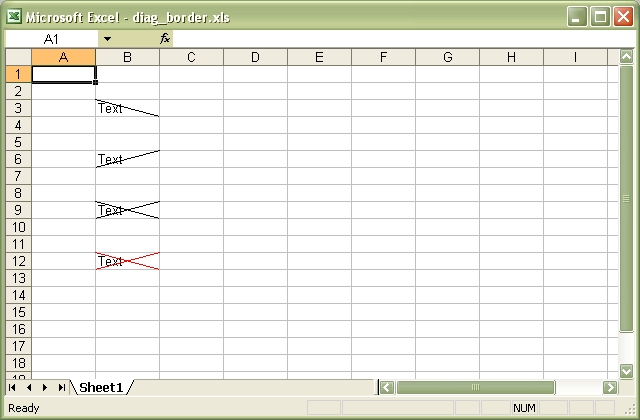
Source code for this example:
#!/usr/bin/perl -w
##############################################################################
#
# A simple formatting example that demonstrates how to add a diagonal cell
# border with Excel::Writer::XLSX
#
# reverse('©'), May 2004, John McNamara, jmcnamara@cpan.org
#
use strict;
use Excel::Writer::XLSX;
my $workbook = Excel::Writer::XLSX->new( 'diag_border.xlsx' );
my $worksheet = $workbook->add_worksheet();
my $format1 = $workbook->add_format( diag_type => '1' );
my $format2 = $workbook->add_format( diag_type => '2' );
my $format3 = $workbook->add_format( diag_type => '3' );
my $format4 = $workbook->add_format(
diag_type => '3',
diag_border => '7',
diag_color => 'red',
);
$worksheet->write( 'B3', 'Text', $format1 );
$worksheet->write( 'B6', 'Text', $format2 );
$worksheet->write( 'B9', 'Text', $format3 );
$worksheet->write( 'B12', 'Text', $format4 );
__END__Download this example: http://cpansearch.perl.org/src/JMCNAMARA/Excel-Writer-XLSX-0.25/examples/diag_border.pl
Example: filehandle.pl
Example of using Excel::Writer::XLSX to write Excel files to different filehandles.
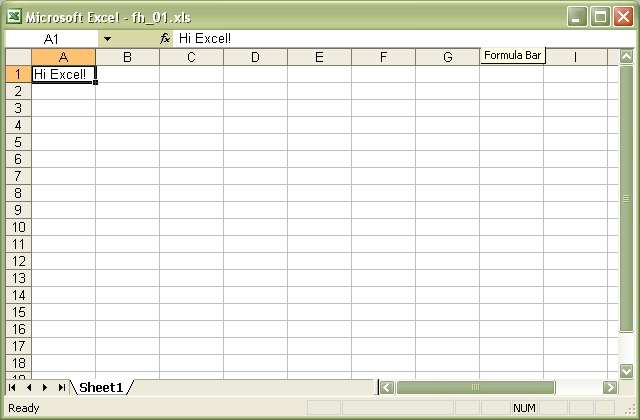
Source code for this example:
#!/usr/bin/perl
###############################################################################
#
# Example of using Excel::Writer::XLSX to write Excel files to different
# filehandles.
#
# reverse('©'), April 2003, John McNamara, jmcnamara@cpan.org
#
use strict;
use warnings;
use Excel::Writer::XLSX;
use IO::Scalar;
###############################################################################
#
# Example 1. This demonstrates the standard way of creating an Excel file by
# specifying a file name.
#
my $workbook1 = Excel::Writer::XLSX->new( 'fh_01.xlsx' );
my $worksheet1 = $workbook1->add_worksheet();
$worksheet1->write( 0, 0, 'Hi Excel 1' );
###############################################################################
#
# Example 2. Write an Excel file to an existing filehandle.
#
open TEST, '>', 'fh_02.xlsx' or die "Couldn't open file: $!";
binmode TEST; # Always do this regardless of whether the platform requires it.
my $workbook2 = Excel::Writer::XLSX->new( \*TEST );
my $worksheet2 = $workbook2->add_worksheet();
$worksheet2->write( 0, 0, 'Hi Excel 2' );
###############################################################################
#
# Example 3. Write an Excel file to an existing OO style filehandle.
#
my $fh = FileHandle->new( '> fh_03.xlsx' ) or die "Couldn't open file: $!";
binmode( $fh );
my $workbook3 = Excel::Writer::XLSX->new( $fh );
my $worksheet3 = $workbook3->add_worksheet();
$worksheet3->write( 0, 0, 'Hi Excel 3' );
###############################################################################
#
# Example 4. Write an Excel file to a string via IO::Scalar. Please refer to
# the IO::Scalar documentation for further details.
#
my $xlsx_str;
tie *XLSX, 'IO::Scalar', \$xlsx_str;
my $workbook4 = Excel::Writer::XLSX->new( \*XLSX );
my $worksheet4 = $workbook4->add_worksheet();
$worksheet4->write( 0, 0, 'Hi Excel 4' );
$workbook4->close(); # This is required before we use the scalar
# The Excel file is now in $xlsx_str. As a demonstration, print it to a file.
open TMP, '>', 'fh_04.xlsx' or die "Couldn't open file: $!";
binmode TMP;
print TMP $xlsx_str;
close TMP;
###############################################################################
#
# Example 5. Write an Excel file to a string via IO::Scalar's newer interface.
# Please refer to the IO::Scalar documentation for further details.
#
my $xlsx_str2;
my $fh5 = IO::Scalar->new( \$xlsx_str2 );
my $workbook5 = Excel::Writer::XLSX->new( $fh5 );
my $worksheet5 = $workbook5->add_worksheet();
$worksheet5->write( 0, 0, 'Hi Excel 5' );
$workbook5->close(); # This is required before we use the scalar
# The Excel file is now in $xlsx_str. As a demonstration, print it to a file.
open TMP, '>', 'fh_05.xlsx' or die "Couldn't open file: $!";
binmode TMP;
print TMP $xlsx_str2;
close TMP;
__END__Download this example: http://cpansearch.perl.org/src/JMCNAMARA/Excel-Writer-XLSX-0.25/examples/filehandle.pl
Example: headers.pl
This program shows several examples of how to set up headers and footers with Excel::Writer::XLSX.
The control characters used in the header/footer strings are:
Control Category Description
======= ======== ===========
&L Justification Left
&C Center
&R Right
&P Information Page number
&N Total number of pages
&D Date
&T Time
&F File name
&A Worksheet name
&fontsize Font Font size
&"font,style" Font name and style
&U Single underline
&E Double underline
&S Strikethrough
&X Superscript
&Y Subscript
&& Miscellaneous Literal ampersand &See the main Excel::Writer::XLSX documentation for more information.
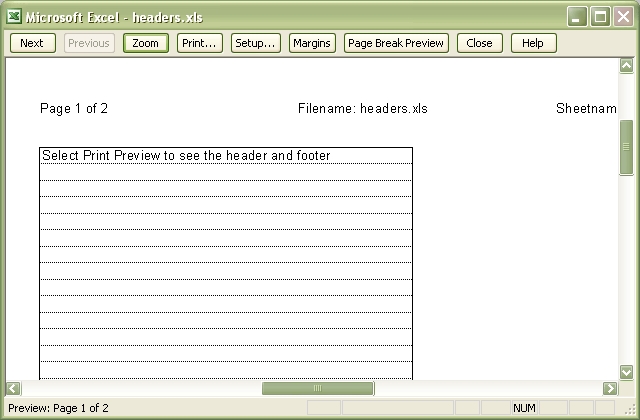
Source code for this example:
#!/usr/bin/perl
######################################################################
#
# This program shows several examples of how to set up headers and
# footers with Excel::Writer::XLSX.
#
# The control characters used in the header/footer strings are:
#
# Control Category Description
# ======= ======== ===========
# &L Justification Left
# &C Center
# &R Right
#
# &P Information Page number
# &N Total number of pages
# &D Date
# &T Time
# &F File name
# &A Worksheet name
#
# &fontsize Font Font size
# &"font,style" Font name and style
# &U Single underline
# &E Double underline
# &S Strikethrough
# &X Superscript
# &Y Subscript
#
# && Miscellaneous Literal ampersand &
#
# See the main Excel::Writer::XLSX documentation for more information.
#
# reverse('©'), March 2002, John McNamara, jmcnamara@cpan.org
#
use strict;
use warnings;
use Excel::Writer::XLSX;
my $workbook = Excel::Writer::XLSX->new( 'headers.xlsx' );
my $preview = 'Select Print Preview to see the header and footer';
######################################################################
#
# A simple example to start
#
my $worksheet1 = $workbook->add_worksheet( 'Simple' );
my $header1 = '&CHere is some centred text.';
my $footer1 = '&LHere is some left aligned text.';
$worksheet1->set_header( $header1 );
$worksheet1->set_footer( $footer1 );
$worksheet1->set_column( 'A:A', 50 );
$worksheet1->write( 'A1', $preview );
######################################################################
#
# This is an example of some of the header/footer variables.
#
my $worksheet2 = $workbook->add_worksheet( 'Variables' );
my $header2 = '&LPage &P of &N' . '&CFilename: &F' . '&RSheetname: &A';
my $footer2 = '&LCurrent date: &D' . '&RCurrent time: &T';
$worksheet2->set_header( $header2 );
$worksheet2->set_footer( $footer2 );
$worksheet2->set_column( 'A:A', 50 );
$worksheet2->write( 'A1', $preview );
$worksheet2->write( 'A21', 'Next sheet' );
$worksheet2->set_h_pagebreaks( 20 );
######################################################################
#
# This example shows how to use more than one font
#
my $worksheet3 = $workbook->add_worksheet( 'Mixed fonts' );
my $header3 = q(&C&"Courier New,Bold"Hello &"Arial,Italic"World);
my $footer3 = q(&C&"Symbol"e&"Arial" = mc&X2);
$worksheet3->set_header( $header3 );
$worksheet3->set_footer( $footer3 );
$worksheet3->set_column( 'A:A', 50 );
$worksheet3->write( 'A1', $preview );
######################################################################
#
# Example of line wrapping
#
my $worksheet4 = $workbook->add_worksheet( 'Word wrap' );
my $header4 = "&CHeading 1\nHeading 2";
$worksheet4->set_header( $header4 );
$worksheet4->set_column( 'A:A', 50 );
$worksheet4->write( 'A1', $preview );
######################################################################
#
# Example of inserting a literal ampersand &
#
my $worksheet5 = $workbook->add_worksheet( 'Ampersand' );
my $header5 = '&CCuriouser && Curiouser - Attorneys at Law';
$worksheet5->set_header( $header5 );
$worksheet5->set_column( 'A:A', 50 );
$worksheet5->write( 'A1', $preview );Download this example: http://cpansearch.perl.org/src/JMCNAMARA/Excel-Writer-XLSX-0.25/examples/headers.pl
Example: hide_sheet.pl
Example of how to hide a worksheet with Excel::Writer::XLSX.
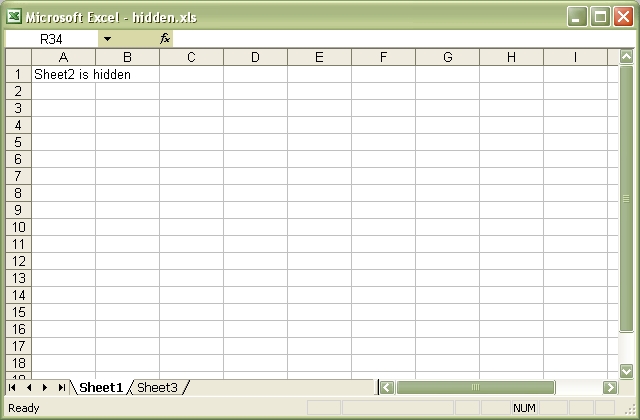
Source code for this example:
#!/usr/bin/perl
#######################################################################
#
# Example of how to hide a worksheet with Excel::Writer::XLSX.
#
# reverse('©'), April 2005, John McNamara, jmcnamara@cpan.org
#
use strict;
use warnings;
use Excel::Writer::XLSX;
my $workbook = Excel::Writer::XLSX->new( 'hide_sheet.xlsx' );
my $worksheet1 = $workbook->add_worksheet();
my $worksheet2 = $workbook->add_worksheet();
my $worksheet3 = $workbook->add_worksheet();
$worksheet1->set_column( 'A:A', 30 );
$worksheet2->set_column( 'A:A', 30 );
$worksheet3->set_column( 'A:A', 30 );
# Sheet2 won't be visible until it is unhidden in Excel.
$worksheet2->hide();
$worksheet1->write( 0, 0, 'Sheet2 is hidden' );
$worksheet2->write( 0, 0, "Now it's my turn to find you." );
$worksheet3->write( 0, 0, 'Sheet2 is hidden' );
__END__Download this example: http://cpansearch.perl.org/src/JMCNAMARA/Excel-Writer-XLSX-0.25/examples/hide_sheet.pl
Example: hyperlink1.pl
Example of how to use the Excel::Writer::XLSX module to write hyperlinks
See also hyperlink2.pl for worksheet URL examples.
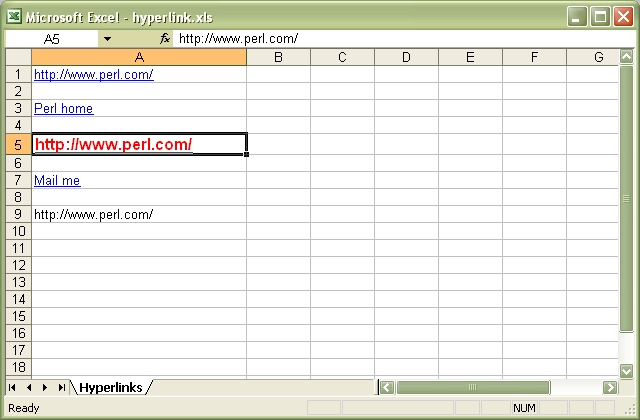
Source code for this example:
#!/usr/bin/perl
###############################################################################
#
# Example of how to use the Excel::Writer::XLSX module to write hyperlinks
#
# See also hyperlink2.pl for worksheet URL examples.
#
# reverse('©'), May 2004, John McNamara, jmcnamara@cpan.org
#
use strict;
use warnings;
use Excel::Writer::XLSX;
# Create a new workbook and add a worksheet
my $workbook = Excel::Writer::XLSX->new( 'hyperlink.xlsx' );
my $worksheet = $workbook->add_worksheet( 'Hyperlinks' );
# Format the first column
$worksheet->set_column( 'A:A', 30 );
$worksheet->set_selection( 'B1' );
# Add the standard url link format.
my $url_format = $workbook->add_format(
color => 'blue',
underline => 1,
);
# Add a sample format.
my $red_format = $workbook->add_format(
color => 'red',
bold => 1,
underline => 1,
size => 12,
);
# Add an alternate description string to the URL.
my $str = 'Perl home.';
# Add a "tool tip" to the URL.
my $tip = 'Get the latest Perl news here.';
# Write some hyperlinks
$worksheet->write( 'A1', 'http://www.perl.com/', $url_format );
$worksheet->write( 'A3', 'http://www.perl.com/', $url_format, $str );
$worksheet->write( 'A5', 'http://www.perl.com/', $url_format, $str, $tip );
$worksheet->write( 'A7', 'http://www.perl.com/', $red_format );
$worksheet->write( 'A9', 'mailto:jmcnamara@cpan.org', $url_format, 'Mail me' );
# Write a URL that isn't a hyperlink
$worksheet->write_string( 'A11', 'http://www.perl.com/' );Download this example: http://cpansearch.perl.org/src/JMCNAMARA/Excel-Writer-XLSX-0.25/examples/hyperlink1.pl
Example: hyperlink2.pl
Example of how to use the Excel::Writer::XLSX module to write internal and external hyperlinks.
If you wish to run this program and follow the hyperlinks you should create the following directory structure:
C:\ -- Temp --+-- Europe | \-- Asia
See also hyperlink1.pl for web URL examples.
#!/usr/bin/perl
###############################################################################
#
# Example of how to use the Excel::Writer::XLSX module to write internal and
# external hyperlinks.
#
# If you wish to run this program and follow the hyperlinks you should create
# the following directory structure:
#
# C:\ -- Temp --+-- Europe
# |
# \-- Asia
#
#
# See also hyperlink1.pl for web URL examples.
#
# reverse('©'), February 2002, John McNamara, jmcnamara@cpan.org
#
use strict;
use warnings;
use Excel::Writer::XLSX;
# Create three workbooks:
# C:\Temp\Europe\Ireland.xlsx
# C:\Temp\Europe\Italy.xlsx
# C:\Temp\Asia\China.xlsx
#
my $ireland = Excel::Writer::XLSX->new( 'C:\Temp\Europe\Ireland.xlsx' );
my $ire_links = $ireland->add_worksheet( 'Links' );
my $ire_sales = $ireland->add_worksheet( 'Sales' );
my $ire_data = $ireland->add_worksheet( 'Product Data' );
my $ire_url_format = $ireland->add_format(
color => 'blue',
underline => 1,
);
my $italy = Excel::Writer::XLSX->new( 'C:\Temp\Europe\Italy.xlsx' );
my $ita_links = $italy->add_worksheet( 'Links' );
my $ita_sales = $italy->add_worksheet( 'Sales' );
my $ita_data = $italy->add_worksheet( 'Product Data' );
my $ita_url_format = $italy->add_format(
color => 'blue',
underline => 1,
);
my $china = Excel::Writer::XLSX->new( 'C:\Temp\Asia\China.xlsx' );
my $cha_links = $china->add_worksheet( 'Links' );
my $cha_sales = $china->add_worksheet( 'Sales' );
my $cha_data = $china->add_worksheet( 'Product Data' );
my $cha_url_format = $china->add_format(
color => 'blue',
underline => 1,
);
# Add an alternative format
my $format = $ireland->add_format( color => 'green', bold => 1 );
$ire_links->set_column( 'A:B', 25 );
###############################################################################
#
# Examples of internal links
#
$ire_links->write( 'A1', 'Internal links', $format );
# Internal link
$ire_links->write_url( 'A2', 'internal:Sales!A2', $ire_url_format );
# Internal link to a range
$ire_links->write_url( 'A3', 'internal:Sales!A3:D3', $ire_url_format );
# Internal link with an alternative string
$ire_links->write_url( 'A4', 'internal:Sales!A4', $ire_url_format, 'Link' );
# Internal link with an alternative format
$ire_links->write_url( 'A5', 'internal:Sales!A5', $format );
# Internal link with an alternative string and format
$ire_links->write_url( 'A6', 'internal:Sales!A6', $ire_url_format, 'Link' );
# Internal link (spaces in worksheet name)
$ire_links->write_url( 'A7', q{internal:'Product Data'!A7}, $ire_url_format );
###############################################################################
#
# Examples of external links
#
$ire_links->write( 'B1', 'External links', $format );
# External link to a local file
$ire_links->write_url( 'B2', 'external:Italy.xlsx', $ire_url_format );
# External link to a local file with worksheet
$ire_links->write_url( 'B3', 'external:Italy.xlsx#Sales!B3', $ire_url_format );
# External link to a local file with worksheet and alternative string
$ire_links->write_url( 'B4', 'external:Italy.xlsx#Sales!B4', $ire_url_format, 'Link' );
# External link to a local file with worksheet and format
$ire_links->write_url( 'B5', 'external:Italy.xlsx#Sales!B5', $format );
# External link to a remote file, absolute path
$ire_links->write_url( 'B6', 'external:C:/Temp/Asia/China.xlsx', $ire_url_format );
# External link to a remote file, relative path
$ire_links->write_url( 'B7', 'external:../Asia/China.xlsx', $ire_url_format );
# External link to a remote file with worksheet
$ire_links->write_url( 'B8', 'external:C:/Temp/Asia/China.xlsx#Sales!B8', $ire_url_format );
# External link to a remote file with worksheet (with spaces in the name)
$ire_links->write_url( 'B9', q{external:C:/Temp/Asia/China.xlsx#'Product Data'!B9}, $ire_url_format );
###############################################################################
#
# Some utility links to return to the main sheet
#
$ire_sales->write_url( 'A2', 'internal:Links!A2', $ire_url_format, 'Back' );
$ire_sales->write_url( 'A3', 'internal:Links!A3', $ire_url_format, 'Back' );
$ire_sales->write_url( 'A4', 'internal:Links!A4', $ire_url_format, 'Back' );
$ire_sales->write_url( 'A5', 'internal:Links!A5', $ire_url_format, 'Back' );
$ire_sales->write_url( 'A6', 'internal:Links!A6', $ire_url_format, 'Back' );
$ire_data->write_url ( 'A7', 'internal:Links!A7', $ire_url_format, 'Back' );
$ita_links->write_url( 'A1', 'external:Ireland.xlsx#Links!B2', $ita_url_format, 'Back' );
$ita_sales->write_url( 'B3', 'external:Ireland.xlsx#Links!B3', $ita_url_format, 'Back' );
$ita_sales->write_url( 'B4', 'external:Ireland.xlsx#Links!B4', $ita_url_format, 'Back' );
$ita_sales->write_url( 'B5', 'external:Ireland.xlsx#Links!B5', $ita_url_format, 'Back' );
$cha_links->write_url( 'A1', 'external:C:/Temp/Europe/Ireland.xlsx#Links!B6', $cha_url_format, 'Back' );
$cha_sales->write_url( 'B8', 'external:C:/Temp/Europe/Ireland.xlsx#Links!B8', $cha_url_format, 'Back' );
$cha_data->write_url ( 'B9', 'external:C:/Temp/Europe/Ireland.xlsx#Links!B9', $cha_url_format, 'Back' );
__END__Download this example: http://cpansearch.perl.org/src/JMCNAMARA/Excel-Writer-XLSX-0.25/examples/hyperlink2.pl
Example: indent.pl
A simple formatting example using Excel::Writer::XLSX.
This program demonstrates the indentation cell format.
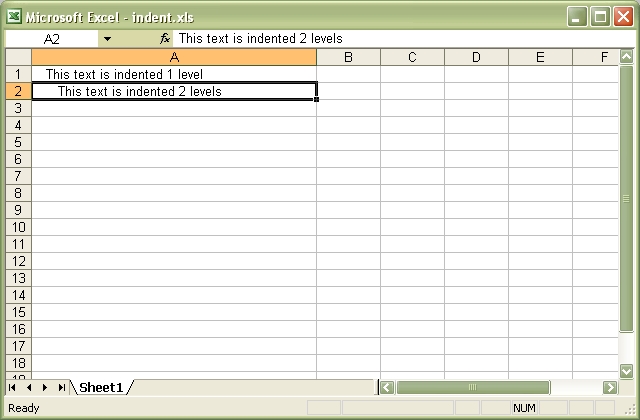
Source code for this example:
#!/usr/bin/perl -w
##############################################################################
#
# A simple formatting example using Excel::Writer::XLSX.
#
# This program demonstrates the indentation cell format.
#
# reverse('©'), May 2004, John McNamara, jmcnamara@cpan.org
#
use strict;
use Excel::Writer::XLSX;
my $workbook = Excel::Writer::XLSX->new( 'indent.xlsx' );
my $worksheet = $workbook->add_worksheet();
my $indent1 = $workbook->add_format( indent => 1 );
my $indent2 = $workbook->add_format( indent => 2 );
$worksheet->set_column( 'A:A', 40 );
$worksheet->write( 'A1', "This text is indented 1 level", $indent1 );
$worksheet->write( 'A2', "This text is indented 2 levels", $indent2 );
__END__Download this example: http://cpansearch.perl.org/src/JMCNAMARA/Excel-Writer-XLSX-0.25/examples/indent.pl
Example: merge1.pl
Simple example of merging cells using the Excel::Writer::XLSX module.
This example merges three cells using the "Centre Across Selection" alignment which was the Excel 5 method of achieving a merge. For a more modern approach use the merge_range() worksheet method instead. See the merge3.pl - merge6.pl programs.
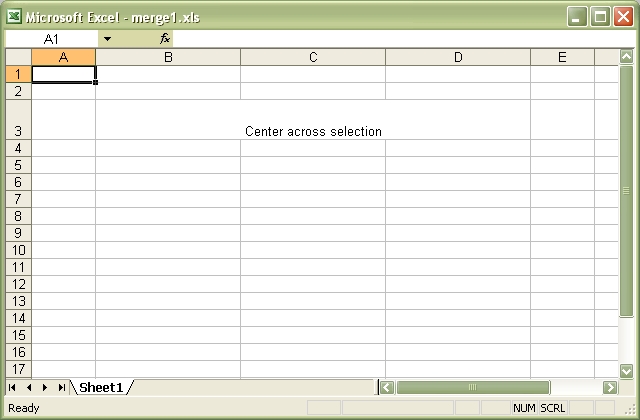
Source code for this example:
#!/usr/bin/perl
###############################################################################
#
# Simple example of merging cells using the Excel::Writer::XLSX module.
#
# This example merges three cells using the "Centre Across Selection"
# alignment which was the Excel 5 method of achieving a merge. For a more
# modern approach use the merge_range() worksheet method instead.
# See the merge3.pl - merge6.pl programs.
#
# reverse('©'), August 2002, John McNamara, jmcnamara@cpan.org
#
use strict;
use warnings;
use Excel::Writer::XLSX;
# Create a new workbook and add a worksheet
my $workbook = Excel::Writer::XLSX->new( 'merge1.xlsx' );
my $worksheet = $workbook->add_worksheet();
# Increase the cell size of the merged cells to highlight the formatting.
$worksheet->set_column( 'B:D', 20 );
$worksheet->set_row( 2, 30 );
# Create a merge format
my $format = $workbook->add_format( center_across => 1 );
# Only one cell should contain text, the others should be blank.
$worksheet->write( 2, 1, "Center across selection", $format );
$worksheet->write_blank( 2, 2, $format );
$worksheet->write_blank( 2, 3, $format );Download this example: http://cpansearch.perl.org/src/JMCNAMARA/Excel-Writer-XLSX-0.25/examples/merge1.pl
Example: merge2.pl
Simple example of merging cells using the Excel::Writer::XLSX module
This example merges three cells using the "Centre Across Selection" alignment which was the Excel 5 method of achieving a merge. For a more modern approach use the merge_range() worksheet method instead. See the merge3.pl - merge6.pl programs.
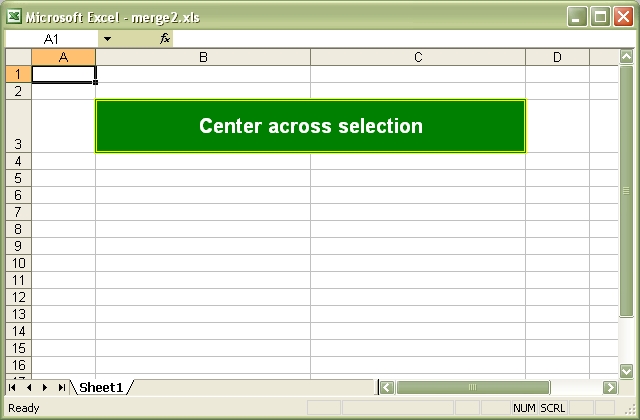
Source code for this example:
#!/usr/bin/perl
###############################################################################
#
# Simple example of merging cells using the Excel::Writer::XLSX module
#
# This example merges three cells using the "Centre Across Selection"
# alignment which was the Excel 5 method of achieving a merge. For a more
# modern approach use the merge_range() worksheet method instead.
# See the merge3.pl - merge6.pl programs.
#
# reverse('©'), August 2002, John McNamara, jmcnamara@cpan.org
#
use strict;
use warnings;
use Excel::Writer::XLSX;
# Create a new workbook and add a worksheet
my $workbook = Excel::Writer::XLSX->new( 'merge2.xlsx' );
my $worksheet = $workbook->add_worksheet();
# Increase the cell size of the merged cells to highlight the formatting.
$worksheet->set_column( 1, 2, 30 );
$worksheet->set_row( 2, 40 );
# Create a merged format
my $format = $workbook->add_format(
center_across => 1,
bold => 1,
size => 15,
pattern => 1,
border => 6,
color => 'white',
fg_color => 'green',
border_color => 'yellow',
align => 'vcenter',
);
# Only one cell should contain text, the others should be blank.
$worksheet->write( 2, 1, "Center across selection", $format );
$worksheet->write_blank( 2, 2, $format );Download this example: http://cpansearch.perl.org/src/JMCNAMARA/Excel-Writer-XLSX-0.25/examples/merge2.pl
Example: merge3.pl
Example of how to use Excel::Writer::XLSX to write a hyperlink in a merged cell.
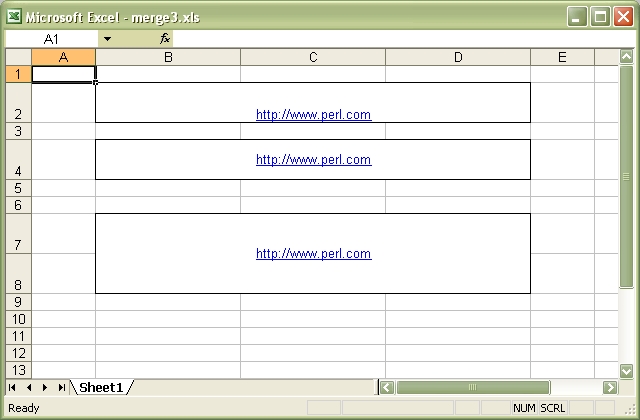
Source code for this example:
#!/usr/bin/perl
###############################################################################
#
# Example of how to use Excel::Writer::XLSX to write a hyperlink in a
# merged cell.
#
# reverse('©'), September 2002, John McNamara, jmcnamara@cpan.org
#
use strict;
use warnings;
use Excel::Writer::XLSX;
# Create a new workbook and add a worksheet
my $workbook = Excel::Writer::XLSX->new( 'merge3.xlsx' );
my $worksheet = $workbook->add_worksheet();
# Increase the cell size of the merged cells to highlight the formatting.
$worksheet->set_row( $_, 30 ) for ( 3, 6, 7 );
$worksheet->set_column( 'B:D', 20 );
###############################################################################
#
# Example: Merge cells containing a hyperlink using merge_range().
#
my $format = $workbook->add_format(
border => 1,
underline => 1,
color => 'blue',
align => 'center',
valign => 'vcenter',
);
# Merge 3 cells
$worksheet->merge_range( 'B4:D4', 'http://www.perl.com', $format );
# Merge 3 cells over two rows
$worksheet->merge_range( 'B7:D8', 'http://www.perl.com', $format );Download this example: http://cpansearch.perl.org/src/JMCNAMARA/Excel-Writer-XLSX-0.25/examples/merge3.pl
Example: merge4.pl
Example of how to use the Excel::Writer::XLSX merge_range() workbook method with complex formatting.
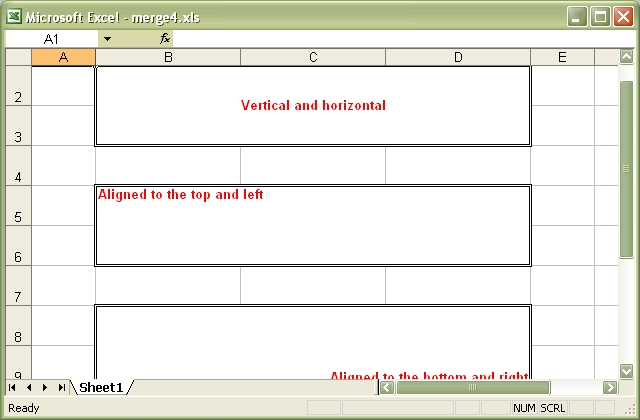
Source code for this example:
#!/usr/bin/perl
###############################################################################
#
# Example of how to use the Excel::Writer::XLSX merge_range() workbook
# method with complex formatting.
#
# reverse('©'), September 2002, John McNamara, jmcnamara@cpan.org
#
use strict;
use warnings;
use Excel::Writer::XLSX;
# Create a new workbook and add a worksheet
my $workbook = Excel::Writer::XLSX->new( 'merge4.xlsx' );
my $worksheet = $workbook->add_worksheet();
# Increase the cell size of the merged cells to highlight the formatting.
$worksheet->set_row( $_, 30 ) for ( 1 .. 11 );
$worksheet->set_column( 'B:D', 20 );
###############################################################################
#
# Example 1: Text centered vertically and horizontally
#
my $format1 = $workbook->add_format(
border => 6,
bold => 1,
color => 'red',
valign => 'vcenter',
align => 'center',
);
$worksheet->merge_range( 'B2:D3', 'Vertical and horizontal', $format1 );
###############################################################################
#
# Example 2: Text aligned to the top and left
#
my $format2 = $workbook->add_format(
border => 6,
bold => 1,
color => 'red',
valign => 'top',
align => 'left',
);
$worksheet->merge_range( 'B5:D6', 'Aligned to the top and left', $format2 );
###############################################################################
#
# Example 3: Text aligned to the bottom and right
#
my $format3 = $workbook->add_format(
border => 6,
bold => 1,
color => 'red',
valign => 'bottom',
align => 'right',
);
$worksheet->merge_range( 'B8:D9', 'Aligned to the bottom and right', $format3 );
###############################################################################
#
# Example 4: Text justified (i.e. wrapped) in the cell
#
my $format4 = $workbook->add_format(
border => 6,
bold => 1,
color => 'red',
valign => 'top',
align => 'justify',
);
$worksheet->merge_range( 'B11:D12', 'Justified: ' . 'so on and ' x 18,
$format4 );Download this example: http://cpansearch.perl.org/src/JMCNAMARA/Excel-Writer-XLSX-0.25/examples/merge4.pl
Example: merge5.pl
Example of how to use the Excel::Writer::XLSX merge_cells() workbook method with complex formatting and rotation.
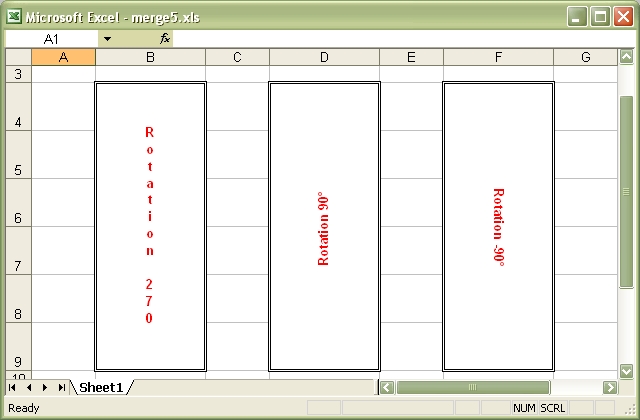
Source code for this example:
#!/usr/bin/perl
###############################################################################
#
# Example of how to use the Excel::Writer::XLSX merge_cells() workbook
# method with complex formatting and rotation.
#
#
# reverse('©'), September 2002, John McNamara, jmcnamara@cpan.org
#
use strict;
use warnings;
use Excel::Writer::XLSX;
# Create a new workbook and add a worksheet
my $workbook = Excel::Writer::XLSX->new( 'merge5.xlsx' );
my $worksheet = $workbook->add_worksheet();
# Increase the cell size of the merged cells to highlight the formatting.
$worksheet->set_row( $_, 36 ) for ( 3 .. 8 );
$worksheet->set_column( $_, $_, 15 ) for ( 1, 3, 5 );
###############################################################################
#
# Rotation 1, letters run from top to bottom
#
my $format1 = $workbook->add_format(
border => 6,
bold => 1,
color => 'red',
valign => 'vcentre',
align => 'centre',
rotation => 270,
);
$worksheet->merge_range( 'B4:B9', 'Rotation 270', $format1 );
###############################################################################
#
# Rotation 2, 90° anticlockwise
#
my $format2 = $workbook->add_format(
border => 6,
bold => 1,
color => 'red',
valign => 'vcentre',
align => 'centre',
rotation => 90,
);
$worksheet->merge_range( 'D4:D9', 'Rotation 90°', $format2 );
###############################################################################
#
# Rotation 3, 90° clockwise
#
my $format3 = $workbook->add_format(
border => 6,
bold => 1,
color => 'red',
valign => 'vcentre',
align => 'centre',
rotation => -90,
);
$worksheet->merge_range( 'F4:F9', 'Rotation -90°', $format3 );Download this example: http://cpansearch.perl.org/src/JMCNAMARA/Excel-Writer-XLSX-0.25/examples/merge5.pl
Example: merge6.pl
Example of how to use the Excel::Writer::XLSX merge_cells() workbook method with Unicode strings.
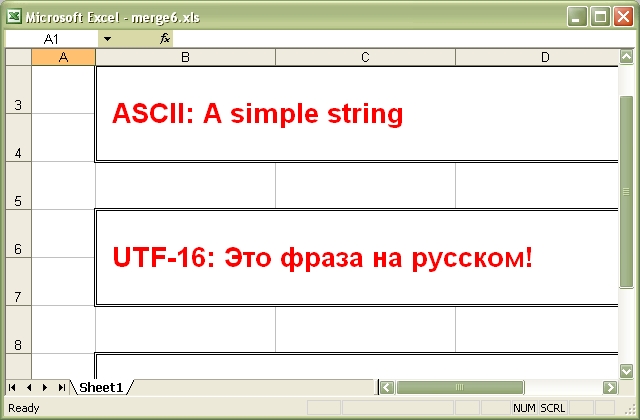
Source code for this example:
#!/usr/bin/perl
###############################################################################
#
# Example of how to use the Excel::Writer::XLSX merge_cells() workbook
# method with Unicode strings.
#
#
# reverse('©'), December 2005, John McNamara, jmcnamara@cpan.org
#
use strict;
use warnings;
use Excel::Writer::XLSX;
# Create a new workbook and add a worksheet
my $workbook = Excel::Writer::XLSX->new( 'merge6.xlsx' );
my $worksheet = $workbook->add_worksheet();
# Increase the cell size of the merged cells to highlight the formatting.
$worksheet->set_row( $_, 36 ) for 2 .. 9;
$worksheet->set_column( 'B:D', 25 );
# Format for the merged cells.
my $format = $workbook->add_format(
border => 6,
bold => 1,
color => 'red',
size => 20,
valign => 'vcentre',
align => 'left',
indent => 1,
);
###############################################################################
#
# Write an Ascii string.
#
$worksheet->merge_range( 'B3:D4', 'ASCII: A simple string', $format );
###############################################################################
#
# Write a UTF-8 Unicode string.
#
my $smiley = chr 0x263a;
$worksheet->merge_range( 'B6:D7', "UTF-8: A Unicode smiley $smiley", $format );
__END__Download this example: http://cpansearch.perl.org/src/JMCNAMARA/Excel-Writer-XLSX-0.25/examples/merge6.pl
Example: mod_perl1.pl
Example of how to use the Excel::Writer::XLSX module to send an Excel file to a browser using mod_perl 1 and Apache
This module ties *XLSX directly to Apache, and with the correct content-disposition/types it will prompt the user to save the file, or open it at this location.
This script is a modification of the Excel::Writer::XLSX cgi.pl example.
Change the name of this file to Cgi.pm. Change the package location to where ever you locate this package. In the example below it is located in the WriteExcel directory.
Your httpd.conf entry for this module, should you choose to use it as a stand alone app, should look similar to the following:
<Location /spreadsheet-test>
SetHandler perl-script
PerlHandler Excel::Writer::XLSX::Cgi
PerlSendHeader On
</Location>The PerlHandler name above and the package name below *have* to match.
###############################################################################
#
# Example of how to use the Excel::Writer::XLSX module to send an Excel
# file to a browser using mod_perl 1 and Apache
#
# This module ties *XLSX directly to Apache, and with the correct
# content-disposition/types it will prompt the user to save
# the file, or open it at this location.
#
# This script is a modification of the Excel::Writer::XLSX cgi.pl example.
#
# Change the name of this file to Cgi.pm.
# Change the package location to where ever you locate this package.
# In the example below it is located in the WriteExcel directory.
#
# Your httpd.conf entry for this module, should you choose to use it
# as a stand alone app, should look similar to the following:
#
# <Location /spreadsheet-test>
# SetHandler perl-script
# PerlHandler Excel::Writer::XLSX::Cgi
# PerlSendHeader On
# </Location>
#
# The PerlHandler name above and the package name below *have* to match.
# Apr 2001, Thomas Sullivan, webmaster@860.org
# Feb 2001, John McNamara, jmcnamara@cpan.org
package Excel::Writer::XLSX::Cgi;
##########################################
# Pragma Definitions
##########################################
use strict;
##########################################
# Required Modules
##########################################
use Apache::Constants qw(:common);
use Apache::Request;
use Apache::URI; # This may not be needed
use Excel::Writer::XLSX;
##########################################
# Main App Body
##########################################
sub handler {
# New apache object
# Should you decide to use it.
my $r = Apache::Request->new( shift );
# Set the filename and send the content type
# This will appear when they save the spreadsheet
my $filename = "cgitest.xlsx";
####################################################
## Send the content type headers
####################################################
print "Content-disposition: attachment;filename=$filename\n";
print "Content-type: application/vnd.ms-excel\n\n";
####################################################
# Tie a filehandle to Apache's STDOUT.
# Create a new workbook and add a worksheet.
####################################################
tie *XLSX => 'Apache';
binmode( *XLSX );
my $workbook = Excel::Writer::XLSX->new( \*XLSX );
my $worksheet = $workbook->add_worksheet();
# Set the column width for column 1
$worksheet->set_column( 0, 0, 20 );
# Create a format
my $format = $workbook->add_format();
$format->set_bold();
$format->set_size( 15 );
$format->set_color( 'blue' );
# Write to the workbook
$worksheet->write( 0, 0, "Hi Excel!", $format );
# You must close the workbook for Content-disposition
$workbook->close();
}
1;Download this example: http://cpansearch.perl.org/src/JMCNAMARA/Excel-Writer-XLSX-0.25/examples/mod_perl1.pl
Example: mod_perl2.pl
Example of how to use the Excel::Writer::XLSX module to send an Excel file to a browser using mod_perl 2 and Apache.
This module ties *XLSX directly to Apache, and with the correct content-disposition/types it will prompt the user to save the file, or open it at this location.
This script is a modification of the Excel::Writer::XLSX cgi.pl example.
Change the name of this file to MP2Test.pm. Change the package location to where ever you locate this package. In the example below it is located in the WriteExcel directory.
Your httpd.conf entry for this module, should you choose to use it as a stand alone app, should look similar to the following:
PerlModule Apache2::RequestRec
PerlModule APR::Table
PerlModule Apache2::RequestIO
<Location /spreadsheet-test>
SetHandler perl-script
PerlResponseHandler Excel::Writer::XLSX::MP2Test
</Location>The PerlResponseHandler must match the package name below.
###############################################################################
#
# Example of how to use the Excel::Writer::XLSX module to send an Excel
# file to a browser using mod_perl 2 and Apache.
#
# This module ties *XLSX directly to Apache, and with the correct
# content-disposition/types it will prompt the user to save
# the file, or open it at this location.
#
# This script is a modification of the Excel::Writer::XLSX cgi.pl example.
#
# Change the name of this file to MP2Test.pm.
# Change the package location to where ever you locate this package.
# In the example below it is located in the WriteExcel directory.
#
# Your httpd.conf entry for this module, should you choose to use it
# as a stand alone app, should look similar to the following:
#
# PerlModule Apache2::RequestRec
# PerlModule APR::Table
# PerlModule Apache2::RequestIO
#
# <Location /spreadsheet-test>
# SetHandler perl-script
# PerlResponseHandler Excel::Writer::XLSX::MP2Test
# </Location>
#
# The PerlResponseHandler must match the package name below.
# Jun 2004, Matisse Enzer, matisse@matisse.net (mod_perl 2 version)
# Apr 2001, Thomas Sullivan, webmaster@860.org
# Feb 2001, John McNamara, jmcnamara@cpan.org
package Excel::Writer::XLSX::MP2Test;
##########################################
# Pragma Definitions
##########################################
use strict;
##########################################
# Required Modules
##########################################
use Apache2::Const -compile => qw( :common );
use Excel::Writer::XLSX;
##########################################
# Main App Body
##########################################
sub handler {
my ( $r ) = @_; # Apache request object is passed to handler in mod_perl 2
# Set the filename and send the content type
# This will appear when they save the spreadsheet
my $filename = "mod_perl2_test.xlsx";
####################################################
## Send the content type headers the mod_perl 2 way
####################################################
$r->headers_out->{'Content-Disposition'} = "attachment;filename=$filename";
$r->content_type( 'application/vnd.ms-excel' );
####################################################
# Tie a filehandle to Apache's STDOUT.
# Create a new workbook and add a worksheet.
####################################################
tie *XLSX => $r; # The mod_perl 2 way. Tie to the Apache::RequestRec object
binmode( *XLSX );
my $workbook = Excel::Writer::XLSX->new( \*XLSX );
my $worksheet = $workbook->add_worksheet();
# Set the column width for column 1
$worksheet->set_column( 0, 0, 20 );
# Create a format
my $format = $workbook->add_format();
$format->set_bold();
$format->set_size( 15 );
$format->set_color( 'blue' );
# Write to the workbook
$worksheet->write( 0, 0, 'Hi Excel! from ' . $r->hostname, $format );
# You must close the workbook for Content-disposition
$workbook->close();
return Apache2::Const::OK;
}
1;Download this example: http://cpansearch.perl.org/src/JMCNAMARA/Excel-Writer-XLSX-0.25/examples/mod_perl2.pl
Example: panes.pl
Example of using the WriteExcel module to create worksheet panes.

Source code for this example:
#!/usr/bin/perl
#######################################################################
#
# Example of using the WriteExcel module to create worksheet panes.
#
# reverse('©'), May 2001, John McNamara, jmcnamara@cpan.org
#
use strict;
use warnings;
use Excel::Writer::XLSX;
my $workbook = Excel::Writer::XLSX->new( 'panes.xlsx' );
my $worksheet1 = $workbook->add_worksheet( 'Panes 1' );
my $worksheet2 = $workbook->add_worksheet( 'Panes 2' );
my $worksheet3 = $workbook->add_worksheet( 'Panes 3' );
my $worksheet4 = $workbook->add_worksheet( 'Panes 4' );
# Freeze panes
$worksheet1->freeze_panes( 1, 0 ); # 1 row
$worksheet2->freeze_panes( 0, 1 ); # 1 column
$worksheet3->freeze_panes( 1, 1 ); # 1 row and column
# Split panes.
# The divisions must be specified in terms of row and column dimensions.
# The default row height is 15 and the default column width is 8.43
#
$worksheet4->split_panes( 15, 8.43 ); # 1 row and column
#######################################################################
#
# Set up some formatting and text to highlight the panes
#
my $header = $workbook->add_format(
align => 'center',
valign => 'vcenter',
fg_color => 0x2A,
);
my $center = $workbook->add_format( align => 'center' );
#######################################################################
#
# Sheet 1
#
$worksheet1->set_column( 'A:I', 16 );
$worksheet1->set_row( 0, 20 );
$worksheet1->set_selection( 'C3' );
for my $i ( 0 .. 8 ) {
$worksheet1->write( 0, $i, 'Scroll down', $header );
}
for my $i ( 1 .. 100 ) {
for my $j ( 0 .. 8 ) {
$worksheet1->write( $i, $j, $i + 1, $center );
}
}
#######################################################################
#
# Sheet 2
#
$worksheet2->set_column( 'A:A', 16 );
$worksheet2->set_selection( 'C3' );
for my $i ( 0 .. 49 ) {
$worksheet2->set_row( $i, 15 );
$worksheet2->write( $i, 0, 'Scroll right', $header );
}
for my $i ( 0 .. 49 ) {
for my $j ( 1 .. 25 ) {
$worksheet2->write( $i, $j, $j, $center );
}
}
#######################################################################
#
# Sheet 3
#
$worksheet3->set_column( 'A:Z', 16 );
$worksheet3->set_selection( 'C3' );
$worksheet3->write( 0, 0, '', $header );
for my $i ( 1 .. 25 ) {
$worksheet3->write( 0, $i, 'Scroll down', $header );
}
for my $i ( 1 .. 49 ) {
$worksheet3->write( $i, 0, 'Scroll right', $header );
}
for my $i ( 1 .. 49 ) {
for my $j ( 1 .. 25 ) {
$worksheet3->write( $i, $j, $j, $center );
}
}
#######################################################################
#
# Sheet 4
#
$worksheet4->set_selection( 'C3' );
for my $i ( 1 .. 25 ) {
$worksheet4->write( 0, $i, 'Scroll', $center );
}
for my $i ( 1 .. 49 ) {
$worksheet4->write( $i, 0, 'Scroll', $center );
}
for my $i ( 1 .. 49 ) {
for my $j ( 1 .. 25 ) {
$worksheet4->write( $i, $j, $j, $center );
}
}Download this example: http://cpansearch.perl.org/src/JMCNAMARA/Excel-Writer-XLSX-0.25/examples/panes.pl
Example: properties.pl
An example of adding document properties to a Excel::Writer::XLSX file.
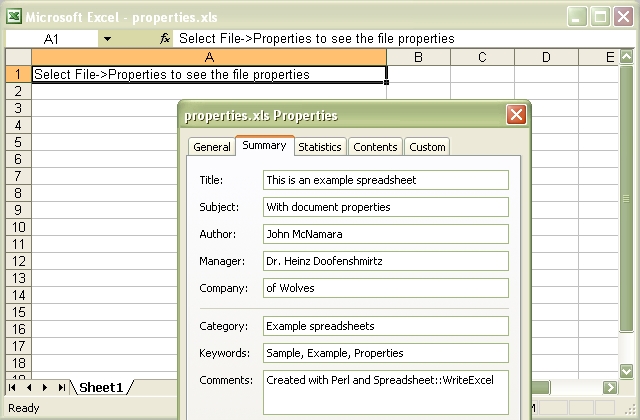
Source code for this example:
#!/usr/bin/perl
##############################################################################
#
# An example of adding document properties to a Excel::Writer::XLSX file.
#
# reverse('©'), August 2008, John McNamara, jmcnamara@cpan.org
#
use strict;
use warnings;
use Excel::Writer::XLSX;
my $workbook = Excel::Writer::XLSX->new( 'properties.xlsx' );
my $worksheet = $workbook->add_worksheet();
$workbook->set_properties(
title => 'This is an example spreadsheet',
subject => 'With document properties',
author => 'John McNamara',
manager => 'Dr. Heinz Doofenshmirtz',
company => 'of Wolves',
category => 'Example spreadsheets',
keywords => 'Sample, Example, Properties',
comments => 'Created with Perl and Excel::Writer::XLSX',
status => 'Quo',
);
$worksheet->set_column( 'A:A', 70 );
$worksheet->write( 'A1', qq{Select 'Office Button -> Prepare -> Properties' to see the file properties.} );
__END__Download this example: http://cpansearch.perl.org/src/JMCNAMARA/Excel-Writer-XLSX-0.25/examples/properties.pl
Example: protection.pl
Example of cell locking and formula hiding in an Excel worksheet via the Excel::Writer::XLSX module.
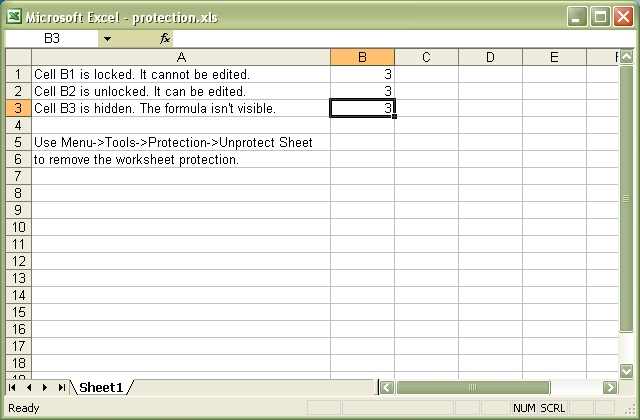
Source code for this example:
#!/usr/bin/perl
########################################################################
#
# Example of cell locking and formula hiding in an Excel worksheet via
# the Excel::Writer::XLSX module.
#
# reverse('©'), August 2001, John McNamara, jmcnamara@cpan.org
#
use strict;
use warnings;
use Excel::Writer::XLSX;
my $workbook = Excel::Writer::XLSX->new( 'protection.xlsx' );
my $worksheet = $workbook->add_worksheet();
# Create some format objects
my $unlocked = $workbook->add_format( locked => 0 );
my $hidden = $workbook->add_format( hidden => 1 );
# Format the columns
$worksheet->set_column( 'A:A', 45 );
$worksheet->set_selection( 'B3' );
# Protect the worksheet
$worksheet->protect();
# Examples of cell locking and hiding.
$worksheet->write( 'A1', 'Cell B1 is locked. It cannot be edited.' );
$worksheet->write_formula( 'B1', '=1+2', undef, 3 ); # Locked by default.
$worksheet->write( 'A2', 'Cell B2 is unlocked. It can be edited.' );
$worksheet->write_formula( 'B2', '=1+2', $unlocked, 3 );
$worksheet->write( 'A3', "Cell B3 is hidden. The formula isn't visible." );
$worksheet->write_formula( 'B3', '=1+2', $hidden, 3 );
$worksheet->write( 'A5', 'Use Menu->Tools->Protection->Unprotect Sheet' );
$worksheet->write( 'A6', 'to remove the worksheet protection.' );
__END__Download this example: http://cpansearch.perl.org/src/JMCNAMARA/Excel-Writer-XLSX-0.25/examples/protection.pl
Example: rich_strings.pl
An Excel::Writer::XLSX example showing how to use "rich strings", i.e., strings with multiple formatting.
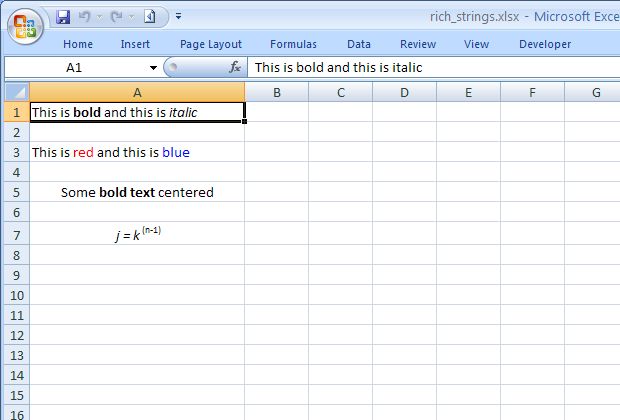
Source code for this example:
#!/usr/bin/perl
#######################################################################
#
# An Excel::Writer::XLSX example showing how to use "rich strings", i.e.,
# strings with multiple formatting.
#
# reverse('©'), February 2011, John McNamara, jmcnamara@cpan.org
#
use strict;
use warnings;
use Excel::Writer::XLSX;
my $workbook = Excel::Writer::XLSX->new( 'rich_strings.xlsx' );
my $worksheet = $workbook->add_worksheet();
$worksheet->set_column( 'A:A', 30 );
# Set some formats to use.
my $bold = $workbook->add_format( bold => 1 );
my $italic = $workbook->add_format( italic => 1 );
my $red = $workbook->add_format( color => 'red' );
my $blue = $workbook->add_format( color => 'blue' );
my $center = $workbook->add_format( align => 'center' );
my $super = $workbook->add_format( font_script => 1 );
# Write some strings with multiple formats.
$worksheet->write_rich_string( 'A1',
'This is ', $bold, 'bold', ' and this is ', $italic, 'italic' );
$worksheet->write_rich_string( 'A3',
'This is ', $red, 'red', ' and this is ', $blue, 'blue' );
$worksheet->write_rich_string( 'A5',
'Some ', $bold, 'bold text', ' centered', $center );
$worksheet->write_rich_string( 'A7',
$italic, 'j = k', $super, '(n-1)', $center );
__END__Download this example: http://cpansearch.perl.org/src/JMCNAMARA/Excel-Writer-XLSX-0.25/examples/rich_strings.pl
Example: right_to_left.pl
Example of how to change the default worksheet direction from left-to-right to right-to-left as required by some eastern verions of Excel.
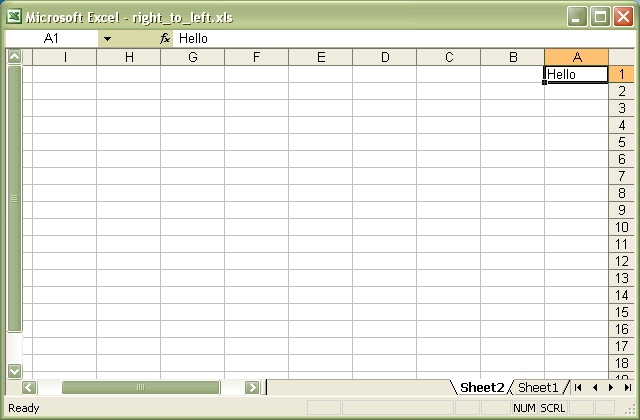
Source code for this example:
#!/usr/bin/perl
#######################################################################
#
# Example of how to change the default worksheet direction from
# left-to-right to right-to-left as required by some eastern verions
# of Excel.
#
# reverse('©'), January 2006, John McNamara, jmcnamara@cpan.org
#
use strict;
use warnings;
use Excel::Writer::XLSX;
my $workbook = Excel::Writer::XLSX->new( 'right_to_left.xlsx' );
my $worksheet1 = $workbook->add_worksheet();
my $worksheet2 = $workbook->add_worksheet();
$worksheet2->right_to_left();
$worksheet1->write( 0, 0, 'Hello' ); # A1, B1, C1, ...
$worksheet2->write( 0, 0, 'Hello' ); # ..., C1, B1, A1Download this example: http://cpansearch.perl.org/src/JMCNAMARA/Excel-Writer-XLSX-0.25/examples/right_to_left.pl
Example: sales.pl
Example of a sales worksheet to demonstrate several different features. Also uses functions from the Excel::Writer::XLSX::Utility module.

Source code for this example:
#!/usr/bin/perl -w
###############################################################################
#
# Example of a sales worksheet to demonstrate several different features.
# Also uses functions from the L<Excel::Writer::XLSX::Utility> module.
#
# reverse('©'), October 2001, John McNamara, jmcnamara@cpan.org
#
use strict;
use Excel::Writer::XLSX;
use Excel::Writer::XLSX::Utility;
# Create a new workbook and add a worksheet
my $workbook = Excel::Writer::XLSX->new( 'sales.xlsx' );
my $worksheet = $workbook->add_worksheet( 'May Sales' );
# Set up some formats
my %heading = (
bold => 1,
pattern => 1,
fg_color => 19,
border => 1,
align => 'center',
);
my %total = (
bold => 1,
top => 1,
num_format => '$#,##0.00'
);
my $heading = $workbook->add_format( %heading );
my $total_format = $workbook->add_format( %total );
my $price_format = $workbook->add_format( num_format => '$#,##0.00' );
my $date_format = $workbook->add_format( num_format => 'mmm d yyy' );
# Write the main headings
$worksheet->freeze_panes( 1 ); # Freeze the first row
$worksheet->write( 'A1', 'Item', $heading );
$worksheet->write( 'B1', 'Quantity', $heading );
$worksheet->write( 'C1', 'Price', $heading );
$worksheet->write( 'D1', 'Total', $heading );
$worksheet->write( 'E1', 'Date', $heading );
# Set the column widths
$worksheet->set_column( 'A:A', 25 );
$worksheet->set_column( 'B:B', 10 );
$worksheet->set_column( 'C:E', 16 );
# Extract the sales data from the __DATA__ section at the end of the file.
# In reality this information would probably come from a database
my @sales;
foreach my $line ( <DATA> ) {
chomp $line;
next if $line eq '';
# Simple-minded processing of CSV data. Refer to the Text::CSV_XS
# and Text::xSV modules for a more complete CSV handling.
my @items = split /,/, $line;
push @sales, \@items;
}
# Write out the items from each row
my $row = 1;
foreach my $sale ( @sales ) {
$worksheet->write( $row, 0, @$sale[0] );
$worksheet->write( $row, 1, @$sale[1] );
$worksheet->write( $row, 2, @$sale[2], $price_format );
# Create a formula like '=B2*C2'
my $formula =
'=' . xl_rowcol_to_cell( $row, 1 ) . "*" . xl_rowcol_to_cell( $row, 2 );
$worksheet->write( $row, 3, $formula, $price_format );
# Parse the date
my $date = xl_decode_date_US( @$sale[3] );
$worksheet->write( $row, 4, $date, $date_format );
$row++;
}
# Create a formula to sum the totals, like '=SUM(D2:D6)'
my $total = '=SUM(D2:' . xl_rowcol_to_cell( $row - 1, 3 ) . ")";
$worksheet->write( $row, 3, $total, $total_format );
__DATA__
586 card,20,125.50,5/12/01
Flat Screen Monitor,1,1300.00,5/12/01
64 MB dimms,45,49.99,5/13/01
15 GB HD,12,300.00,5/13/01
Speakers (pair),5,15.50,5/14/01Download this example: http://cpansearch.perl.org/src/JMCNAMARA/Excel-Writer-XLSX-0.25/examples/sales.pl
Example: stats_ext.pl
Example of formatting using the Excel::Writer::XLSX module
This is a simple example of how to use functions that reference cells in other worksheets within the same workbook.
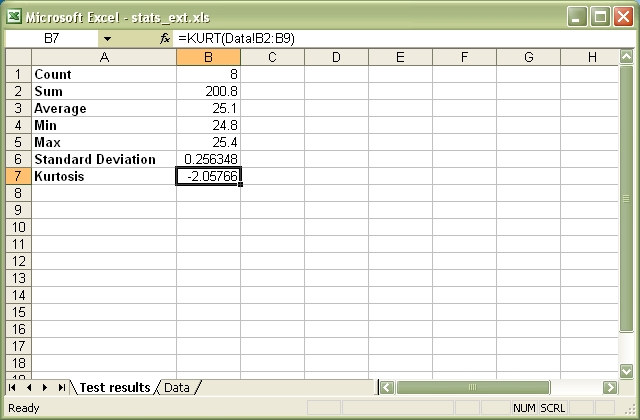
Source code for this example:
#!/usr/bin/perl -w
###############################################################################
#
# Example of formatting using the Excel::Writer::XLSX module
#
# This is a simple example of how to use functions that reference cells in
# other worksheets within the same workbook.
#
# reverse('©'), March 2001, John McNamara, jmcnamara@cpan.org
#
use strict;
use Excel::Writer::XLSX;
# Create a new workbook and add a worksheet
my $workbook = Excel::Writer::XLSX->new( 'stats_ext.xlsx' );
my $worksheet1 = $workbook->add_worksheet( 'Test results' );
my $worksheet2 = $workbook->add_worksheet( 'Data' );
# Set the column width for columns 1
$worksheet1->set_column( 'A:A', 20 );
# Create a format for the headings
my $heading = $workbook->add_format();
$heading->set_bold();
# Create a numerical format
my $numformat = $workbook->add_format();
$numformat->set_num_format( '0.00' );
# Write some statistical functions
$worksheet1->write( 'A1', 'Count', $heading );
$worksheet1->write( 'B1', '=COUNT(Data!B2:B9)' );
$worksheet1->write( 'A2', 'Sum', $heading );
$worksheet1->write( 'B2', '=SUM(Data!B2:B9)' );
$worksheet1->write( 'A3', 'Average', $heading );
$worksheet1->write( 'B3', '=AVERAGE(Data!B2:B9)' );
$worksheet1->write( 'A4', 'Min', $heading );
$worksheet1->write( 'B4', '=MIN(Data!B2:B9)' );
$worksheet1->write( 'A5', 'Max', $heading );
$worksheet1->write( 'B5', '=MAX(Data!B2:B9)' );
$worksheet1->write( 'A6', 'Standard Deviation', $heading );
$worksheet1->write( 'B6', '=STDEV(Data!B2:B9)' );
$worksheet1->write( 'A7', 'Kurtosis', $heading );
$worksheet1->write( 'B7', '=KURT(Data!B2:B9)' );
# Write the sample data
$worksheet2->write( 'A1', 'Sample', $heading );
$worksheet2->write( 'A2', 1 );
$worksheet2->write( 'A3', 2 );
$worksheet2->write( 'A4', 3 );
$worksheet2->write( 'A5', 4 );
$worksheet2->write( 'A6', 5 );
$worksheet2->write( 'A7', 6 );
$worksheet2->write( 'A8', 7 );
$worksheet2->write( 'A9', 8 );
$worksheet2->write( 'B1', 'Length', $heading );
$worksheet2->write( 'B2', 25.4, $numformat );
$worksheet2->write( 'B3', 25.4, $numformat );
$worksheet2->write( 'B4', 24.8, $numformat );
$worksheet2->write( 'B5', 25.0, $numformat );
$worksheet2->write( 'B6', 25.3, $numformat );
$worksheet2->write( 'B7', 24.9, $numformat );
$worksheet2->write( 'B8', 25.2, $numformat );
$worksheet2->write( 'B9', 24.8, $numformat );Download this example: http://cpansearch.perl.org/src/JMCNAMARA/Excel-Writer-XLSX-0.25/examples/stats_ext.pl
Example: stocks.pl
Example of formatting using the Excel::Writer::XLSX module
This example shows how to use a conditional numerical format with colours to indicate if a share price has gone up or down.

Source code for this example:
#!/usr/bin/perl -w
###############################################################################
#
# Example of formatting using the Excel::Writer::XLSX module
#
# This example shows how to use a conditional numerical format
# with colours to indicate if a share price has gone up or down.
#
# reverse('©'), March 2001, John McNamara, jmcnamara@cpan.org
#
use strict;
use Excel::Writer::XLSX;
# Create a new workbook and add a worksheet
my $workbook = Excel::Writer::XLSX->new( 'stocks.xlsx' );
my $worksheet = $workbook->add_worksheet();
# Set the column width for columns 1, 2, 3 and 4
$worksheet->set_column( 0, 3, 15 );
# Create a format for the column headings
my $header = $workbook->add_format();
$header->set_bold();
$header->set_size( 12 );
$header->set_color( 'blue' );
# Create a format for the stock price
my $f_price = $workbook->add_format();
$f_price->set_align( 'left' );
$f_price->set_num_format( '$0.00' );
# Create a format for the stock volume
my $f_volume = $workbook->add_format();
$f_volume->set_align( 'left' );
$f_volume->set_num_format( '#,##0' );
# Create a format for the price change. This is an example of a conditional
# format. The number is formatted as a percentage. If it is positive it is
# formatted in green, if it is negative it is formatted in red and if it is
# zero it is formatted as the default font colour (in this case black).
# Note: the [Green] format produces an unappealing lime green. Try
# [Color 10] instead for a dark green.
#
my $f_change = $workbook->add_format();
$f_change->set_align( 'left' );
$f_change->set_num_format( '[Green]0.0%;[Red]-0.0%;0.0%' );
# Write out the data
$worksheet->write( 0, 0, 'Company', $header );
$worksheet->write( 0, 1, 'Price', $header );
$worksheet->write( 0, 2, 'Volume', $header );
$worksheet->write( 0, 3, 'Change', $header );
$worksheet->write( 1, 0, 'Damage Inc.' );
$worksheet->write( 1, 1, 30.25, $f_price ); # $30.25
$worksheet->write( 1, 2, 1234567, $f_volume ); # 1,234,567
$worksheet->write( 1, 3, 0.085, $f_change ); # 8.5% in green
$worksheet->write( 2, 0, 'Dump Corp.' );
$worksheet->write( 2, 1, 1.56, $f_price ); # $1.56
$worksheet->write( 2, 2, 7564, $f_volume ); # 7,564
$worksheet->write( 2, 3, -0.015, $f_change ); # -1.5% in red
$worksheet->write( 3, 0, 'Rev Ltd.' );
$worksheet->write( 3, 1, 0.13, $f_price ); # $0.13
$worksheet->write( 3, 2, 321, $f_volume ); # 321
$worksheet->write( 3, 3, 0, $f_change ); # 0 in the font color (black)Download this example: http://cpansearch.perl.org/src/JMCNAMARA/Excel-Writer-XLSX-0.25/examples/stocks.pl
Example: tab_colors.pl
Example of how to set Excel worksheet tab colours.
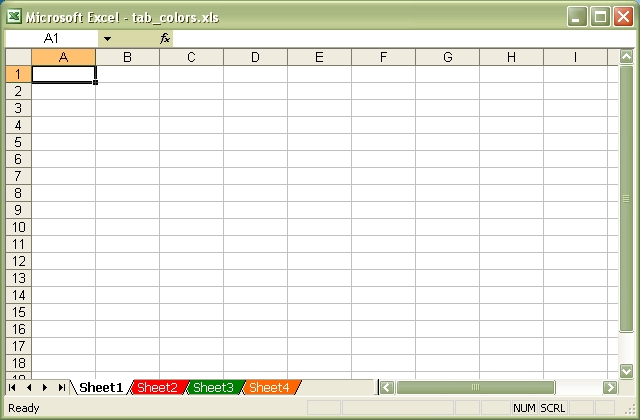
Source code for this example:
#!/usr/bin/perl
#######################################################################
#
# Example of how to set Excel worksheet tab colours.
#
# reverse('©'), May 2006, John McNamara, jmcnamara@cpan.org
#
use strict;
use warnings;
use Excel::Writer::XLSX;
my $workbook = Excel::Writer::XLSX->new( 'tab_colors.xlsx' );
my $worksheet1 = $workbook->add_worksheet();
my $worksheet2 = $workbook->add_worksheet();
my $worksheet3 = $workbook->add_worksheet();
my $worksheet4 = $workbook->add_worksheet();
# Worksheet1 will have the default tab colour.
$worksheet2->set_tab_color( 'red' );
$worksheet3->set_tab_color( 'green' );
$worksheet4->set_tab_color( 0x35 ); # OrangeDownload this example: http://cpansearch.perl.org/src/JMCNAMARA/Excel-Writer-XLSX-0.25/examples/tab_colors.pl
Example: write_handler1.pl
Example of how to add a user defined data handler to the Excel::Writer::XLSX write() method.
The following example shows how to add a handler for a 7 digit ID number.
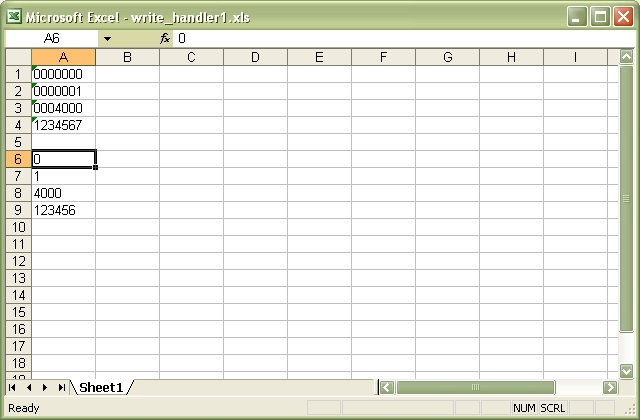
Source code for this example:
#!/usr/bin/perl -w
###############################################################################
#
# Example of how to add a user defined data handler to the
# Excel::Writer::XLSX write() method.
#
# The following example shows how to add a handler for a 7 digit ID number.
#
#
# reverse('©'), September 2004, John McNamara, jmcnamara@cpan.org
#
use strict;
use Excel::Writer::XLSX;
my $workbook = Excel::Writer::XLSX->new( 'write_handler1.xlsx' );
my $worksheet = $workbook->add_worksheet();
###############################################################################
#
# Add a handler for 7 digit id numbers. This is useful when you want a string
# such as 0000001 written as a string instead of a number and thus preserve
# the leading zeroes.
#
# Note: you can get the same effect using the keep_leading_zeros() method but
# this serves as a simple example.
#
$worksheet->add_write_handler( qr[^\d{7}$], \&write_my_id );
###############################################################################
#
# The following function processes the data when a match is found.
#
sub write_my_id {
my $worksheet = shift;
return $worksheet->write_string( @_ );
}
# This format maintains the cell as text even if it is edited.
my $id_format = $workbook->add_format( num_format => '@' );
# Write some numbers in the user defined format
$worksheet->write( 'A1', '0000000', $id_format );
$worksheet->write( 'A2', '0000001', $id_format );
$worksheet->write( 'A3', '0004000', $id_format );
$worksheet->write( 'A4', '1234567', $id_format );
# Write some numbers that don't match the defined format
$worksheet->write( 'A6', '000000', $id_format );
$worksheet->write( 'A7', '000001', $id_format );
$worksheet->write( 'A8', '004000', $id_format );
$worksheet->write( 'A9', '123456', $id_format );
__END__Download this example: http://cpansearch.perl.org/src/JMCNAMARA/Excel-Writer-XLSX-0.25/examples/write_handler1.pl
Example: write_handler2.pl
Example of how to add a user defined data handler to the Excel::Writer::XLSX write() method.
The following example shows how to add a handler for a 7 digit ID number. It adds an additional constraint to the write_handler1.pl in that it only filters data that isn't in the third column.
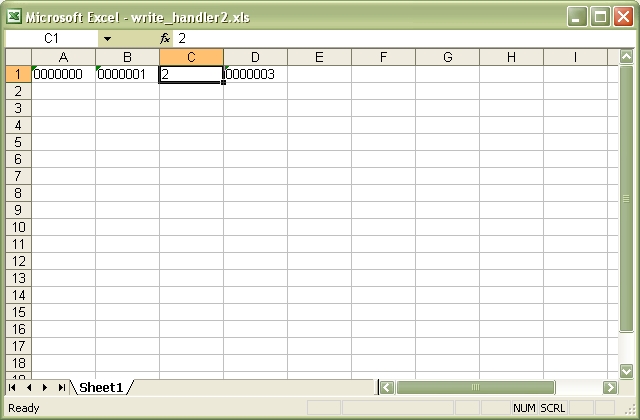
Source code for this example:
#!/usr/bin/perl -w
###############################################################################
#
# Example of how to add a user defined data handler to the
# Excel::Writer::XLSX write() method.
#
# The following example shows how to add a handler for a 7 digit ID number.
# It adds an additional constraint to the write_handler1.pl in that it only
# filters data that isn't in the third column.
#
#
# reverse('©'), September 2004, John McNamara, jmcnamara@cpan.org
#
use strict;
use Excel::Writer::XLSX;
my $workbook = Excel::Writer::XLSX->new( 'write_handler2.xlsx' );
my $worksheet = $workbook->add_worksheet();
###############################################################################
#
# Add a handler for 7 digit id numbers. This is useful when you want a string
# such as 0000001 written as a string instead of a number and thus preserve
# the leading zeroes.
#
# Note: you can get the same effect using the keep_leading_zeros() method but
# this serves as a simple example.
#
$worksheet->add_write_handler( qr[^\d{7}$], \&write_my_id );
###############################################################################
#
# The following function processes the data when a match is found. The handler
# is set up so that it only filters data if it is in the third column.
#
sub write_my_id {
my $worksheet = shift;
my $col = $_[1];
# col is zero based
if ( $col != 2 ) {
return $worksheet->write_string( @_ );
}
else {
# Reject the match and return control to write()
return undef;
}
}
# This format maintains the cell as text even if it is edited.
my $id_format = $workbook->add_format( num_format => '@' );
# Write some numbers in the user defined format
$worksheet->write( 'A1', '0000000', $id_format );
$worksheet->write( 'B1', '0000001', $id_format );
$worksheet->write( 'C1', '0000002', $id_format );
$worksheet->write( 'D1', '0000003', $id_format );
__END__Download this example: http://cpansearch.perl.org/src/JMCNAMARA/Excel-Writer-XLSX-0.25/examples/write_handler2.pl
Example: write_handler3.pl
Example of how to add a user defined data handler to the Excel::Writer::XLSX write() method.
The following example shows how to add a handler for dates in a specific format.
See write_handler4.pl for a more rigorous example with error handling.
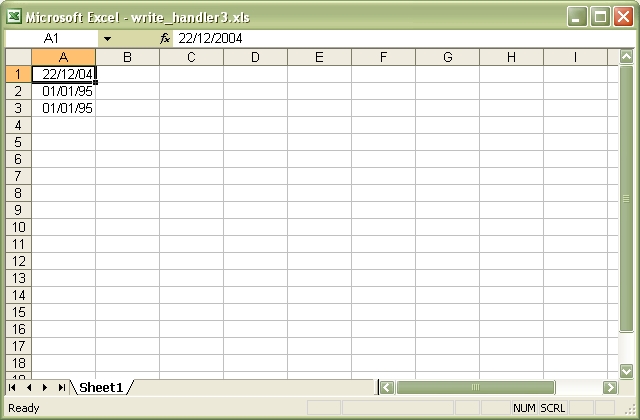
Source code for this example:
#!/usr/bin/perl -w
###############################################################################
#
# Example of how to add a user defined data handler to the
# Excel::Writer::XLSX write() method.
#
# The following example shows how to add a handler for dates in a specific
# format.
#
# See write_handler4.pl for a more rigorous example with error handling.
#
# reverse('©'), September 2004, John McNamara, jmcnamara@cpan.org
#
use strict;
use Excel::Writer::XLSX;
my $workbook = Excel::Writer::XLSX->new( 'write_handler3.xlsx' );
my $worksheet = $workbook->add_worksheet();
my $date_format = $workbook->add_format( num_format => 'dd/mm/yy' );
###############################################################################
#
# Add a handler to match dates in the following format: d/m/yyyy
#
# The day and month can be single or double digits.
#
$worksheet->add_write_handler( qr[^\d{1,2}/\d{1,2}/\d{4}$], \&write_my_date );
###############################################################################
#
# The following function processes the data when a match is found.
# See write_handler4.pl for a more rigorous example with error handling.
#
sub write_my_date {
my $worksheet = shift;
my @args = @_;
my $token = $args[2];
$token =~ qr[^(\d{1,2})/(\d{1,2})/(\d{4})$];
# Change to the date format required by write_date_time().
my $date = sprintf "%4d-%02d-%02dT", $3, $2, $1;
$args[2] = $date;
return $worksheet->write_date_time( @args );
}
# Write some dates in the user defined format
$worksheet->write( 'A1', '22/12/2004', $date_format );
$worksheet->write( 'A2', '1/1/1995', $date_format );
$worksheet->write( 'A3', '01/01/1995', $date_format );
__END__Download this example: http://cpansearch.perl.org/src/JMCNAMARA/Excel-Writer-XLSX-0.25/examples/write_handler3.pl
Example: write_handler4.pl
Example of how to add a user defined data handler to the Excel::Writer::XLSX write() method.
The following example shows how to add a handler for dates in a specific format.
This is a more rigorous version of write_handler3.pl.
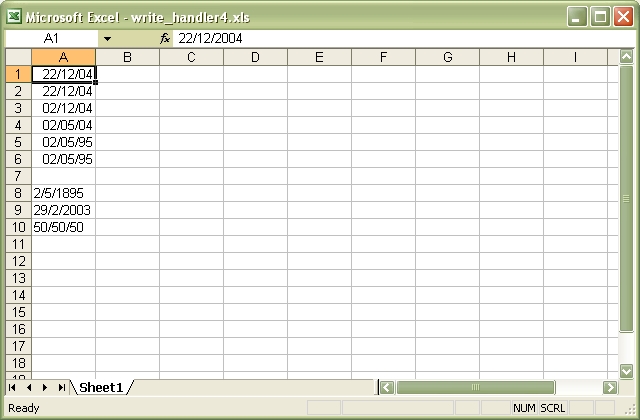
Source code for this example:
#!/usr/bin/perl -w
###############################################################################
#
# Example of how to add a user defined data handler to the
# Excel::Writer::XLSX write() method.
#
# The following example shows how to add a handler for dates in a specific
# format.
#
# This is a more rigorous version of write_handler3.pl.
#
# reverse('©'), September 2004, John McNamara, jmcnamara@cpan.org
#
use strict;
use Excel::Writer::XLSX;
my $workbook = Excel::Writer::XLSX->new( 'write_handler4.xlsx' );
my $worksheet = $workbook->add_worksheet();
my $date_format = $workbook->add_format( num_format => 'dd/mm/yy' );
###############################################################################
#
# Add a handler to match dates in the following formats: d/m/yy, d/m/yyyy
#
# The day and month can be single or double digits and the year can be 2 or 4
# digits.
#
$worksheet->add_write_handler( qr[^\d{1,2}/\d{1,2}/\d{2,4}$], \&write_my_date );
###############################################################################
#
# The following function processes the data when a match is found.
#
sub write_my_date {
my $worksheet = shift;
my @args = @_;
my $token = $args[2];
if ( $token =~ qr[^(\d{1,2})/(\d{1,2})/(\d{2,4})$] ) {
my $day = $1;
my $mon = $2;
my $year = $3;
# Use a window for 2 digit dates. This will keep some ragged Perl
# programmer employed in thirty years time. :-)
if ( length $year == 2 ) {
if ( $year < 50 ) {
$year += 2000;
}
else {
$year += 1900;
}
}
my $date = sprintf "%4d-%02d-%02dT", $year, $mon, $day;
# Convert the ISO ISO8601 style string to an Excel date
$date = $worksheet->convert_date_time( $date );
if ( defined $date ) {
# Date was valid
$args[2] = $date;
return $worksheet->write_number( @args );
}
else {
# Not a valid date therefore write as a string
return $worksheet->write_string( @args );
}
}
else {
# Shouldn't happen if the same match is used in the re and sub.
return undef;
}
}
# Write some dates in the user defined format
$worksheet->write( 'A1', '22/12/2004', $date_format );
$worksheet->write( 'A2', '22/12/04', $date_format );
$worksheet->write( 'A3', '2/12/04', $date_format );
$worksheet->write( 'A4', '2/5/04', $date_format );
$worksheet->write( 'A5', '2/5/95', $date_format );
$worksheet->write( 'A6', '2/5/1995', $date_format );
# Some erroneous dates
$worksheet->write( 'A8', '2/5/1895', $date_format ); # Date out of Excel range
$worksheet->write( 'A9', '29/2/2003', $date_format ); # Invalid leap day
$worksheet->write( 'A10', '50/50/50', $date_format ); # Matches but isn't a date
__END__Download this example: http://cpansearch.perl.org/src/JMCNAMARA/Excel-Writer-XLSX-0.25/examples/write_handler4.pl
Example: write_to_scalar.pl
An example of writing an Excel::Writer::XLSX file to a perl scalar.
#!/usr/bin/perl
##############################################################################
#
# An example of writing an Excel::Writer::XLSX file to a perl scalar.
#
# reverse('©'), September 2004, John McNamara, jmcnamara@cpan.org
#
use strict;
use warnings;
use Excel::Writer::XLSX;
# Use a scalar as a filehandle.
open my $fh, '>', \my $str or die "Failed to open filehandle: $!";
# Spreadsheet::WriteExce accepts filehandle as well as file names.
my $workbook = Excel::Writer::XLSX->new( $fh );
my $worksheet = $workbook->add_worksheet();
$worksheet->write( 0, 0, 'Hi Excel!' );
$workbook->close();
# The Excel file in now in $str. Remember to binmode() the output
# filehandle before printing it.
open my $out_fh, '>', 'write_to_scalar.xlsx'
or die "Failed to open out filehandle: $!";
binmode $out_fh;
print $out_fh $str;
close $out_fh;
__END__Download this example: http://cpansearch.perl.org/src/JMCNAMARA/Excel-Writer-XLSX-0.25/examples/write_to_scalar.pl
Example: unicode_2022_jp.pl
A simple example of converting some Unicode text to an Excel file using Excel::Writer::XLSX.
This example generates some Japanese from a file with ISO-2022-JP encoded text.
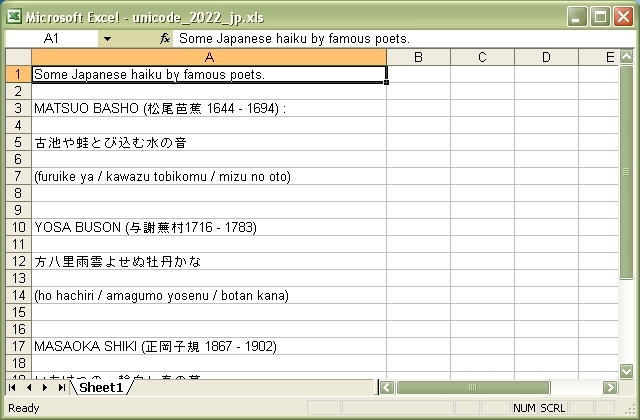
Source code for this example:
#!/usr/bin/perl
##############################################################################
#
# A simple example of converting some Unicode text to an Excel file using
# Excel::Writer::XLSX.
#
# This example generates some Japanese from a file with ISO-2022-JP
# encoded text.
#
# reverse('©'), September 2004, John McNamara, jmcnamara@cpan.org
#
use strict;
use warnings;
use Excel::Writer::XLSX;
my $workbook = Excel::Writer::XLSX->new( 'unicode_2022_jp.xlsx' );
die "Couldn't create new Excel file: $!.\n" unless defined $workbook;
my $worksheet = $workbook->add_worksheet();
$worksheet->set_column( 'A:A', 50 );
my $file = 'unicode_2022_jp.txt';
open FH, '<:encoding(iso-2022-jp)', $file or die "Couldn't open $file: $!\n";
my $row = 0;
while ( <FH> ) {
next if /^#/; # Ignore the comments in the sample file.
chomp;
$worksheet->write( $row++, 0, $_ );
}
__END__Download this example: http://cpansearch.perl.org/src/JMCNAMARA/Excel-Writer-XLSX-0.25/examples/unicode_2022_jp.pl
Example: unicode_8859_11.pl
A simple example of converting some Unicode text to an Excel file using Excel::Writer::XLSX.
This example generates some Thai from a file with ISO-8859-11 encoded text.
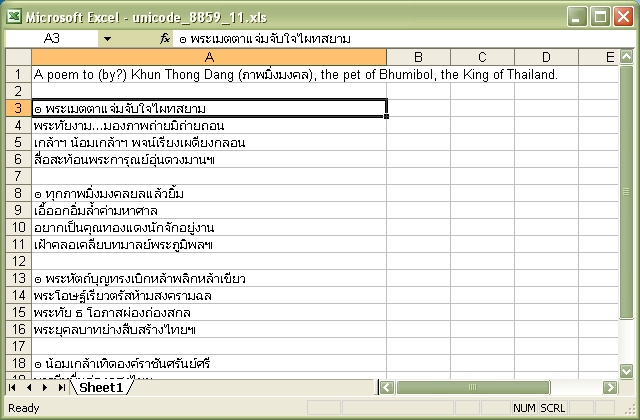
Source code for this example:
#!/usr/bin/perl
##############################################################################
#
# A simple example of converting some Unicode text to an Excel file using
# Excel::Writer::XLSX.
#
# This example generates some Thai from a file with ISO-8859-11 encoded text.
#
#
# reverse('©'), September 2004, John McNamara, jmcnamara@cpan.org
#
use strict;
use warnings;
use Excel::Writer::XLSX;
my $workbook = Excel::Writer::XLSX->new( 'unicode_8859_11.xlsx' );
die "Couldn't create new Excel file: $!.\n" unless defined $workbook;
my $worksheet = $workbook->add_worksheet();
$worksheet->set_column( 'A:A', 50 );
my $file = 'unicode_8859_11.txt';
open FH, '<:encoding(iso-8859-11)', $file or die "Couldn't open $file: $!\n";
my $row = 0;
while ( <FH> ) {
next if /^#/; # Ignore the comments in the sample file.
chomp;
$worksheet->write( $row++, 0, $_ );
}
__END__Download this example: http://cpansearch.perl.org/src/JMCNAMARA/Excel-Writer-XLSX-0.25/examples/unicode_8859_11.pl
Example: unicode_8859_7.pl
A simple example of converting some Unicode text to an Excel file using Excel::Writer::XLSX.
This example generates some Greek from a file with ISO-8859-7 encoded text.
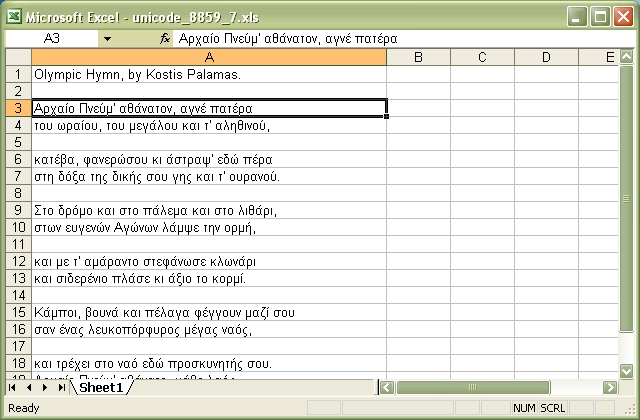
Source code for this example:
#!/usr/bin/perl
##############################################################################
#
# A simple example of converting some Unicode text to an Excel file using
# Excel::Writer::XLSX.
#
# This example generates some Greek from a file with ISO-8859-7 encoded text.
#
#
# reverse('©'), September 2004, John McNamara, jmcnamara@cpan.org
#
use strict;
use warnings;
use Excel::Writer::XLSX;
my $workbook = Excel::Writer::XLSX->new( 'unicode_8859_7.xlsx' );
die "Couldn't create new Excel file: $!.\n" unless defined $workbook;
my $worksheet = $workbook->add_worksheet();
$worksheet->set_column( 'A:A', 50 );
my $file = 'unicode_8859_7.txt';
open FH, '<:encoding(iso-8859-7)', $file or die "Couldn't open $file: $!\n";
my $row = 0;
while ( <FH> ) {
next if /^#/; # Ignore the comments in the sample file.
chomp;
$worksheet->write( $row++, 0, $_ );
}
__END__Download this example: http://cpansearch.perl.org/src/JMCNAMARA/Excel-Writer-XLSX-0.25/examples/unicode_8859_7.pl
Example: unicode_big5.pl
A simple example of converting some Unicode text to an Excel file using Excel::Writer::XLSX.
This example generates some Chinese from a file with BIG5 encoded text.
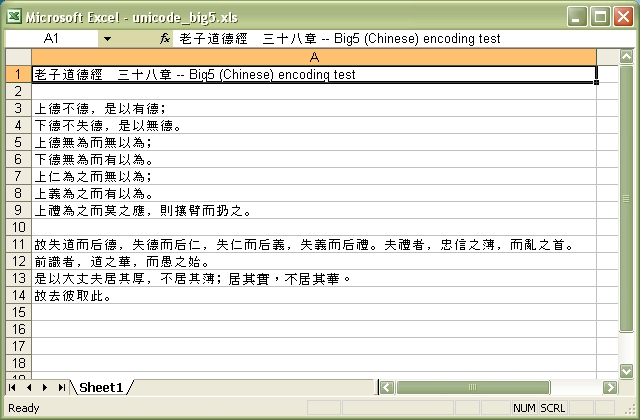
Source code for this example:
#!/usr/bin/perl
##############################################################################
#
# A simple example of converting some Unicode text to an Excel file using
# Excel::Writer::XLSX.
#
# This example generates some Chinese from a file with BIG5 encoded text.
#
#
# reverse('©'), September 2004, John McNamara, jmcnamara@cpan.org
#
use strict;
use warnings;
use Excel::Writer::XLSX;
my $workbook = Excel::Writer::XLSX->new( 'unicode_big5.xlsx' );
die "Couldn't create new Excel file: $!.\n" unless defined $workbook;
my $worksheet = $workbook->add_worksheet();
$worksheet->set_column( 'A:A', 80 );
my $file = 'unicode_big5.txt';
open FH, '<:encoding(big5)', $file or die "Couldn't open $file: $!\n";
my $row = 0;
while ( <FH> ) {
next if /^#/; # Ignore the comments in the sample file.
chomp;
$worksheet->write( $row++, 0, $_ );
}
__END__Download this example: http://cpansearch.perl.org/src/JMCNAMARA/Excel-Writer-XLSX-0.25/examples/unicode_big5.pl
Example: unicode_cp1251.pl
A simple example of converting some Unicode text to an Excel file using Excel::Writer::XLSX.
This example generates some Russian from a file with CP1251 encoded text.
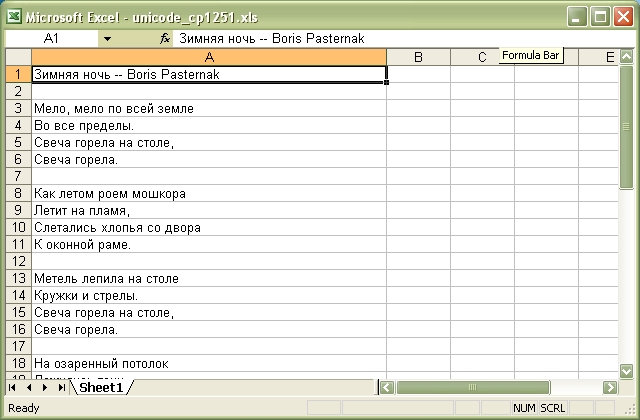
Source code for this example:
#!/usr/bin/perl
##############################################################################
#
# A simple example of converting some Unicode text to an Excel file using
# Excel::Writer::XLSX.
#
# This example generates some Russian from a file with CP1251 encoded text.
#
#
# reverse('©'), September 2004, John McNamara, jmcnamara@cpan.org
#
use strict;
use warnings;
use Excel::Writer::XLSX;
my $workbook = Excel::Writer::XLSX->new( 'unicode_cp1251.xlsx' );
die "Couldn't create new Excel file: $!.\n" unless defined $workbook;
my $worksheet = $workbook->add_worksheet();
$worksheet->set_column( 'A:A', 50 );
my $file = 'unicode_cp1251.txt';
open FH, '<:encoding(cp1251)', $file or die "Couldn't open $file: $!\n";
my $row = 0;
while ( <FH> ) {
next if /^#/; # Ignore the comments in the sample file.
chomp;
$worksheet->write( $row++, 0, $_ );
}
__END__Download this example: http://cpansearch.perl.org/src/JMCNAMARA/Excel-Writer-XLSX-0.25/examples/unicode_cp1251.pl
Example: unicode_cp1256.pl
A simple example of converting some Unicode text to an Excel file using Excel::Writer::XLSX.
This example generates some Arabic text from a CP-1256 encoded file.

Source code for this example:
#!/usr/bin/perl
##############################################################################
#
# A simple example of converting some Unicode text to an Excel file using
# Excel::Writer::XLSX.
#
# This example generates some Arabic text from a CP-1256 encoded file.
#
#
# reverse('©'), September 2004, John McNamara, jmcnamara@cpan.org
#
use strict;
use warnings;
use Excel::Writer::XLSX;
my $workbook = Excel::Writer::XLSX->new( 'unicode_cp1256.xlsx' );
die "Couldn't create new Excel file: $!.\n" unless defined $workbook;
my $worksheet = $workbook->add_worksheet();
$worksheet->set_column( 'A:A', 50 );
my $file = 'unicode_cp1256.txt';
open FH, '<:encoding(cp1256)', $file or die "Couldn't open $file: $!\n";
my $row = 0;
while ( <FH> ) {
next if /^#/; # Ignore the comments in the sample file.
chomp;
$worksheet->write( $row++, 0, $_ );
}
__END__Download this example: http://cpansearch.perl.org/src/JMCNAMARA/Excel-Writer-XLSX-0.25/examples/unicode_cp1256.pl
Example: unicode_cyrillic.pl
A simple example of writing some Russian cyrillic text using Excel::Writer::XLSX.
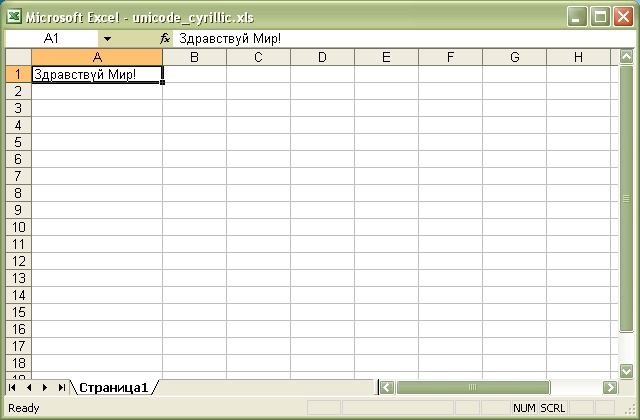
Source code for this example:
#!/usr/bin/perl
##############################################################################
#
# A simple example of writing some Russian cyrillic text using
# Excel::Writer::XLSX.
#
#
#
#
# reverse('©'), March 2005, John McNamara, jmcnamara@cpan.org
#
use strict;
use warnings;
use Excel::Writer::XLSX;
# In this example we generate utf8 strings from character data but in a
# real application we would expect them to come from an external source.
#
# Create a Russian worksheet name in utf8.
my $sheet = pack "U*", 0x0421, 0x0442, 0x0440, 0x0430, 0x043D, 0x0438,
0x0446, 0x0430;
# Create a Russian string.
my $str = pack "U*", 0x0417, 0x0434, 0x0440, 0x0430, 0x0432, 0x0441,
0x0442, 0x0432, 0x0443, 0x0439, 0x0020, 0x041C,
0x0438, 0x0440, 0x0021;
my $workbook = Excel::Writer::XLSX->new( 'unicode_cyrillic.xlsx' );
die "Couldn't create new Excel file: $!.\n" unless defined $workbook;
my $worksheet = $workbook->add_worksheet( $sheet . '1' );
$worksheet->set_column( 'A:A', 18 );
$worksheet->write( 'A1', $str );
__END__Download this example: http://cpansearch.perl.org/src/JMCNAMARA/Excel-Writer-XLSX-0.25/examples/unicode_cyrillic.pl
Example: unicode_koi8r.pl
A simple example of converting some Unicode text to an Excel file using Excel::Writer::XLSX.
This example generates some Russian from a file with KOI8-R encoded text.
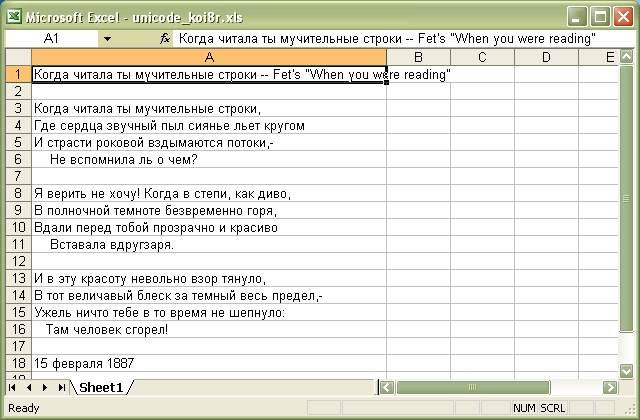
Source code for this example:
#!/usr/bin/perl
##############################################################################
#
# A simple example of converting some Unicode text to an Excel file using
# Excel::Writer::XLSX.
#
# This example generates some Russian from a file with KOI8-R encoded text.
#
#
# reverse('©'), September 2004, John McNamara, jmcnamara@cpan.org
#
use strict;
use warnings;
use Excel::Writer::XLSX;
my $workbook = Excel::Writer::XLSX->new( 'unicode_koi8r.xlsx' );
die "Couldn't create new Excel file: $!.\n" unless defined $workbook;
my $worksheet = $workbook->add_worksheet();
$worksheet->set_column( 'A:A', 50 );
my $file = 'unicode_koi8r.txt';
open FH, '<:encoding(koi8-r)', $file or die "Couldn't open $file: $!\n";
my $row = 0;
while ( <FH> ) {
next if /^#/; # Ignore the comments in the sample file.
chomp;
$worksheet->write( $row++, 0, $_ );
}
__END__Download this example: http://cpansearch.perl.org/src/JMCNAMARA/Excel-Writer-XLSX-0.25/examples/unicode_koi8r.pl
Example: unicode_polish_utf8.pl
A simple example of converting some Unicode text to an Excel file using Excel::Writer::XLSX.
This example generates some Polish from a file with UTF8 encoded text.
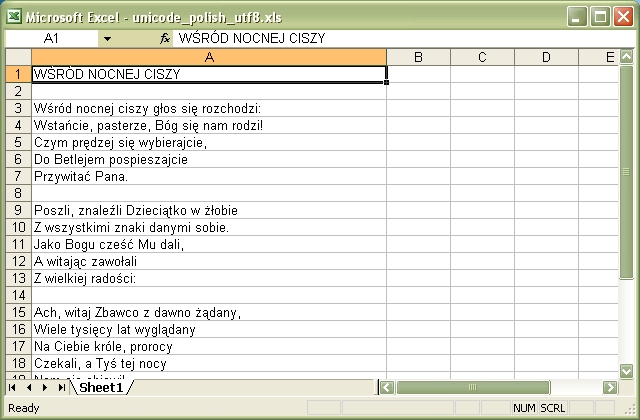
Source code for this example:
#!/usr/bin/perl
##############################################################################
#
# A simple example of converting some Unicode text to an Excel file using
# Excel::Writer::XLSX.
#
# This example generates some Polish from a file with UTF8 encoded text.
#
#
# reverse('©'), September 2004, John McNamara, jmcnamara@cpan.org
#
use strict;
use warnings;
use Excel::Writer::XLSX;
my $workbook = Excel::Writer::XLSX->new( 'unicode_polish_utf8.xlsx' );
die "Couldn't create new Excel file: $!.\n" unless defined $workbook;
my $worksheet = $workbook->add_worksheet();
$worksheet->set_column( 'A:A', 50 );
my $file = 'unicode_polish_utf8.txt';
open FH, '<:encoding(utf8)', $file or die "Couldn't open $file: $!\n";
my $row = 0;
while ( <FH> ) {
next if /^#/; # Ignore the comments in the sample file.
chomp;
$worksheet->write( $row++, 0, $_ );
}
__END__Download this example: http://cpansearch.perl.org/src/JMCNAMARA/Excel-Writer-XLSX-0.25/examples/unicode_polish_utf8.pl
Example: unicode_shift_jis.pl
A simple example of converting some Unicode text to an Excel file using Excel::Writer::XLSX.
This example generates some Japenese text from a file with Shift-JIS encoded text.
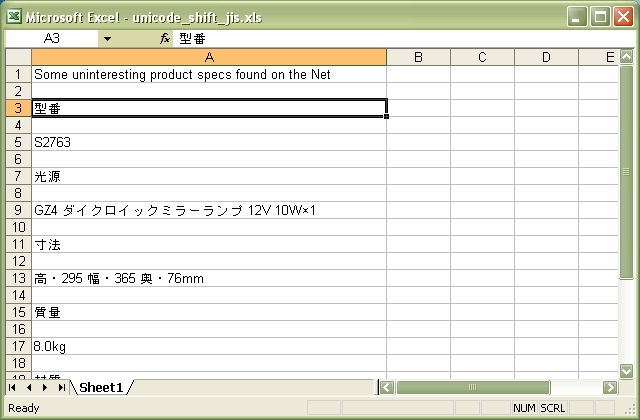
Source code for this example:
#!/usr/bin/perl
##############################################################################
#
# A simple example of converting some Unicode text to an Excel file using
# Excel::Writer::XLSX.
#
# This example generates some Japenese text from a file with Shift-JIS
# encoded text.
#
# reverse('©'), September 2004, John McNamara, jmcnamara@cpan.org
#
use strict;
use warnings;
use Excel::Writer::XLSX;
my $workbook = Excel::Writer::XLSX->new( 'unicode_shift_jis.xlsx' );
die "Couldn't create new Excel file: $!.\n" unless defined $workbook;
my $worksheet = $workbook->add_worksheet();
$worksheet->set_column( 'A:A', 50 );
my $file = 'unicode_shift_jis.txt';
open FH, '<:encoding(shiftjis)', $file or die "Couldn't open $file: $!\n";
my $row = 0;
while ( <FH> ) {
next if /^#/; # Ignore the comments in the sample file.
chomp;
$worksheet->write( $row++, 0, $_ );
}
__END__Download this example: http://cpansearch.perl.org/src/JMCNAMARA/Excel-Writer-XLSX-0.25/examples/unicode_shift_jis.pl
AUTHOR
John McNamara jmcnamara@cpan.org
Contributed examples contain the original author's name.
COPYRIGHT
Copyright MM-MMXI, John McNamara.
All Rights Reserved. This module is free software. It may be used, redistributed and/or modified under the same terms as Perl itself.
1 POD Error
The following errors were encountered while parsing the POD:
- Around line 190:
Non-ASCII character seen before =encoding in 'reverse('©'),'. Assuming CP1252